

Find



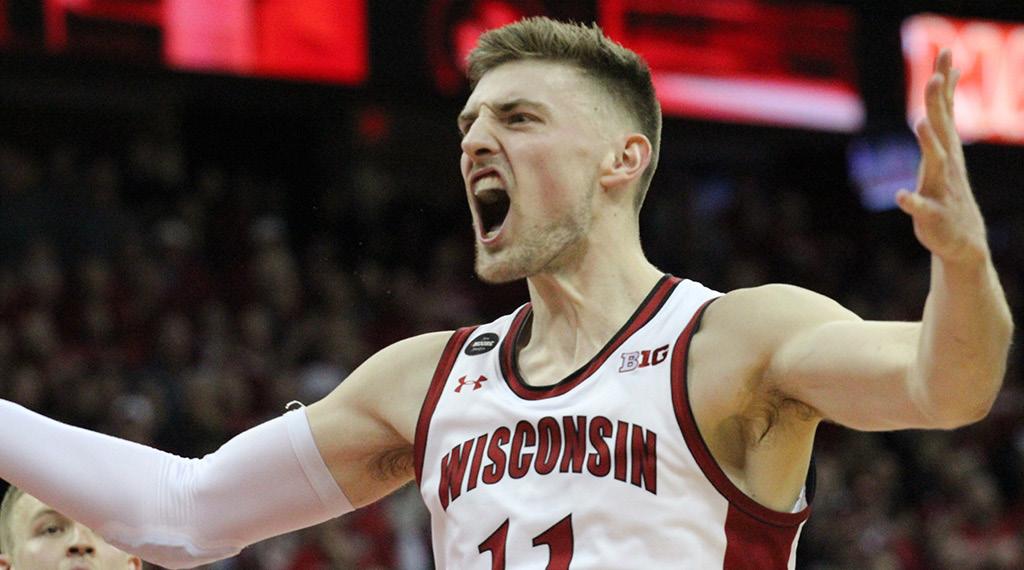
Follow
Follow
Like




Find




Follow
Follow
Like



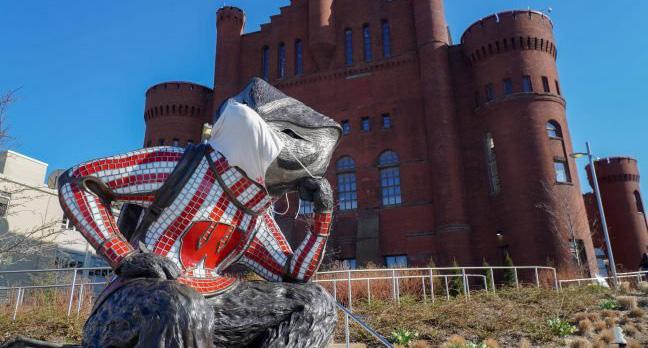

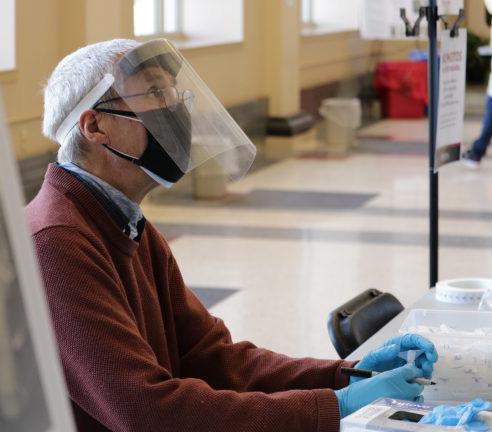
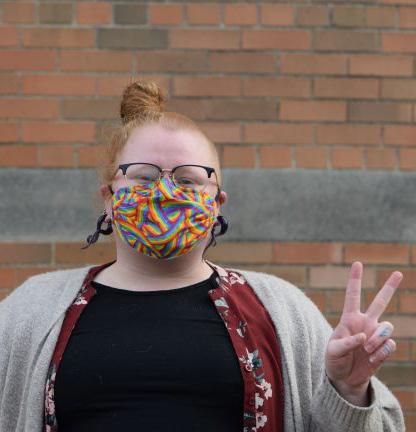
Two special agents from the Department of Justice fired at Quadren Wilson Feb. 3, who sustained five shots in the back. About a month later, protesters and community members are still increasingly frustrated with the lack of transparency surrounding the investigation.
In a statement released Feb. 21, Dane County Executive Joe Parisi expressed his frustrations with the silence on the side of the police.
“This has not been a transparent process,” Parisi said. “Many questions about this case remain unanswered, such as what happened and why — why such a massive law enforcement presence and such an apparently violent arrest.”
There were 21 officers on the scene the morning police shot Wilson, including 13 Division of Criminal Investigation agents, three federal Drug Enforcement Administration agents, three Madison Police Department officers, one Wisconsin State Patrol trooper and one Wisconsin Department of Natural Resources warden, according to Tone Madison.
To try to understand the lack of information available to the public from the police, The Badger Herald contacted Kenneth Streit, a criminal justice expert and clinical associate professor at the University of Wisconsin.
According to Streit, the police may be
withholding information in order to better understand how to handle the situation themselves.
“Regarding Mr. Wilson, given the number of law enforcement persons and agencies involved and the method of stopping Wilson’s vehicle, it is an extraordinary event,” Streit said. “My guess is that there was significant confidential information and surveillance invested and that the delays in informing the public are somewhat due to trying to figure out how to proceed.”
As of right now, there is no evidence to indicate that Wilson was armed. According to prior reporting by The Herald, the Dane County Sheriff’s Office has not located any evidence to support the notion that Quadren Wilson was armed at the time the DCI agents shot him.
Wilson had his hands up and was complying with the officers on the scene, according to Wilson’s attorney Steve Eisenberg. In an interview with Tone Madison, Eisenberg described the incident.
“His hands went up and then he was shot,” Eisenberg said.
Jessica Williams, a domestic violence advocate with Freedom Inc., expressed her frustration and doubt regarding this incident.
Williams referenced the previous shooting of Tony Robinson, a 19 year old from Madison who was killed in his house by Madison police in 2015. Williams made it clear that the tragedy
of this occurrence was magnified by the fact that the Madison community seen so many stories like it.
“It’s really sad that it happened, but it’s not unusual at this point,” Williams said. “We have another Black man who was treated like a threat while he was unarmed, and shot in the back.”
The demand for more information about the events of that morning is clear and apparent, but there is no body camera footage. At the time of the shooting, the camera was facing away from the incident, according to NBC 15.


A proposal to dedicate $83,000 to fund the use of 48 body-worn cameras on police in the North District of Madison was set to be discussed before Wilson was shot, but the Madison City Council pushed it back until April 17, according to The Herald.
The proposal was pushed back for a number of reasons, one of them cited by Alderperson Patrick Heck as lack of funding. The council’s cost estimates included using the overtime budget for the MPD to fund some of the pilot program.
Heck said, because overtime budgets are for emergencies and unexpected expenses, some council members were hesitant to discuss the issue at that time.
While it is still unclear how city council will decide to act regarding this proposal, the $83,000 budgeted for it pales in comparison to the reported $1 million in added funding to the police department in 2022 alone.
Moreover, the city council recently passed a resolution for accepting a federal grant worth $750,000 that would increase the MPD’s policeforce, and Heck is one of the 13 alders who voted to accept the grant. The city would have to pay $600,000 each year for some years to
fund the newly-hired police officers’ salaries.
According to a comprehensive review of body-worn cameras in 2019, researchers did not observe statistically significant effects of body-worn cameras on most police-citizen interactions. Researchers are still unclear about the extent to which body-worn cameras influence policing outcomes and suggest exploring their impact as a tool for police reform.
Though it is not a perfect solution, Streit believes body-worn cameras could counter the inconsistencies of witness testimony and, in this instance, would potentially hold the answers to many of the questions that people like Sarisi and Williams have been asking.
“My research leads me to fully endorse the use of body cameras,” Streit said. “I think the presence of the cameras would lead to more accurate fact-finding regarding what actually is taking place during encounters — a time when both parties may later have a difficult time remembering.”
On the other hand, Williams said Freedom Inc. is against the implementation of body cameras for the MPD.
Williams expressed concerns that body cameras could be maliciously used to “target and surveil” Black individuals more than before. Williams also said, even with video footage of police officers attacking Black people, they often don’t lead to any justice for the victims.
“Even when there has been footage, the outcome hasn’t been any different,” Williams said. “I don’t think that, since police officers nationwide have started to wear body-worn cameras, that the rates of police murders of Black people have decreased, you know?”
‘We have another Black man who was treated like a threat while he was unarmed, and shot in the back,’ Freedom Inc. representative saysPhoto · 21 officers were on the scene when police shot Wilson, including 13 Division of Criminal Investigation agents Emily Hamer The Badger Herald Photo · A proposal to dedicate $83,000 to fund the use of 48 body-worn cameras was proposed before the incident Kate Cooney The Badger Herald
facebook.com/badgerherald
Chancellor Rebecca Blank gave her final State of the University address to the University of Wisconsin System Board of Regents in February.
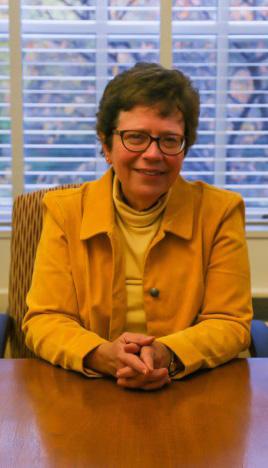
In her address, Blank offered several suggestions to the Board of Regents about UW-Madison specifically, such as the approval of borrowing authority for capital projects and an active engagement with leadership when they criticize UWMadison.
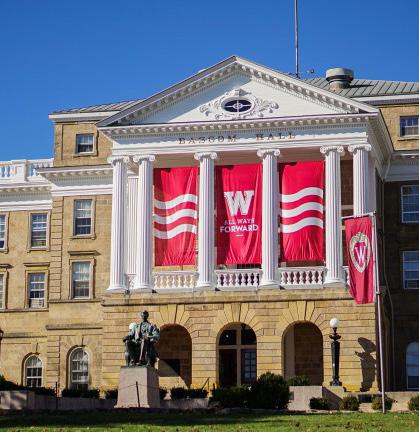
“For a person leaving for a new leadership position, she was very proactive,” Regent Rodney Pasch said in an interview with The Badger Herald.
Pasch said he believes the Blank offered these recommendations because she wants
to help the university grow and succeed, even in her absence.
Regent President Edmund Manydeeds III — a member of the new chancellor search committee — said he believes Blank made the recommendations out of love for the UW-Madison campus and in good hope for its future.
Manydeeds appreciated Blank’s recommendations but said he didn’t believe they held much weight because the most pressing concern currently for the Board of Regents is finding the next chancellor.
“What’s the next chancellor going to think about those things?” Manydeeds said.
Manydeeds said the board will wait to see what the new chancellor thinks about these recommendations, but critical voices
for him now are those of the university staff, community and students who all have different expectations for the new chancellor.
Pasch said he hopes the next chancellor uses the important resources at UW to further cement the school’s legacy as a world-class university.
“I hope they continue to give leadership in a changing world with a lot of new dynamics,” Pasch said.
The Board of Regents announced the chancellor search in December and held listening sessions in January to hear from any students and staff about their expectations for a new chancellor.
Now, the search committee is receiving applications through March 11, after which they will start reading applications and hold interviews for promising candidates through April.
In May, they will interview the finalists from that interview pool and then select a final candidate to hire.
“We want someone who is going to represent the university,” Manydeeds said.
Manydeeds said he’s hoping for a diverse pool of candidates, saying he assumed most will come with high qualifications. Manydeeds also said he’d like to have a chancellor with strong communications skills, which Pasch highlighted as something he noticed in particular about Blank. Pasch said she is a brilliant and smart leader and really helped students learn and grow during her time at the university.
In her speech, Blank shared several achievements during her time as chancellor, including creating a more diverse student body, strengthening financial aid and significantly increasing the number of National Merit finalists who attend the university.
“These institutions are fragile, particularly at a high level of quality,” Blank said. “If we aren’t working every day to maintain and grow this quality, it will erode.”
The Cap Times reported Blank said the university should grow their research enterprise in order to strengthen UWMadison financially and to prevent decrease in revenue.
advocate of Blank and is curious about finding out new chancellor’s pursuits on campus will be like.
“If we’re going to maintain our reputation and our quality, we need to continue to invest and grow in the right ways,” Blank said. “To do that, we need resources – and we will help generate those — combined with a smart strategy for the future. That will be the job of the new chancellor.”
Pasch said while he is also a fan of Blank, he’s optimistic about the future. According to him, the state legislature and the governor have been very proactive in supporting education in Wisconsin, but did not go into detail how.
Photo · Board of Regents president says recommendations are appreciated, but the Board’s most pressing concern is Blank’s replacement as the chancellor search continues
This is something Blank said she focused on during her time at the university, and she hopes that the Board of Regents and the new chancellor will continue to improve this area.
Manydeeds said he has been a major
Manydeeds talked about the role of the search committee and said that they were listening to the opinions of the whole community in their search for a chancellor.
“I want the students to know that we have valued everything we’ve heard from them and their representatives who came to the listening session,” Manydeeds said.
The WSUM station was quiet Friday afternoon as they prepared to host a live band on the air.
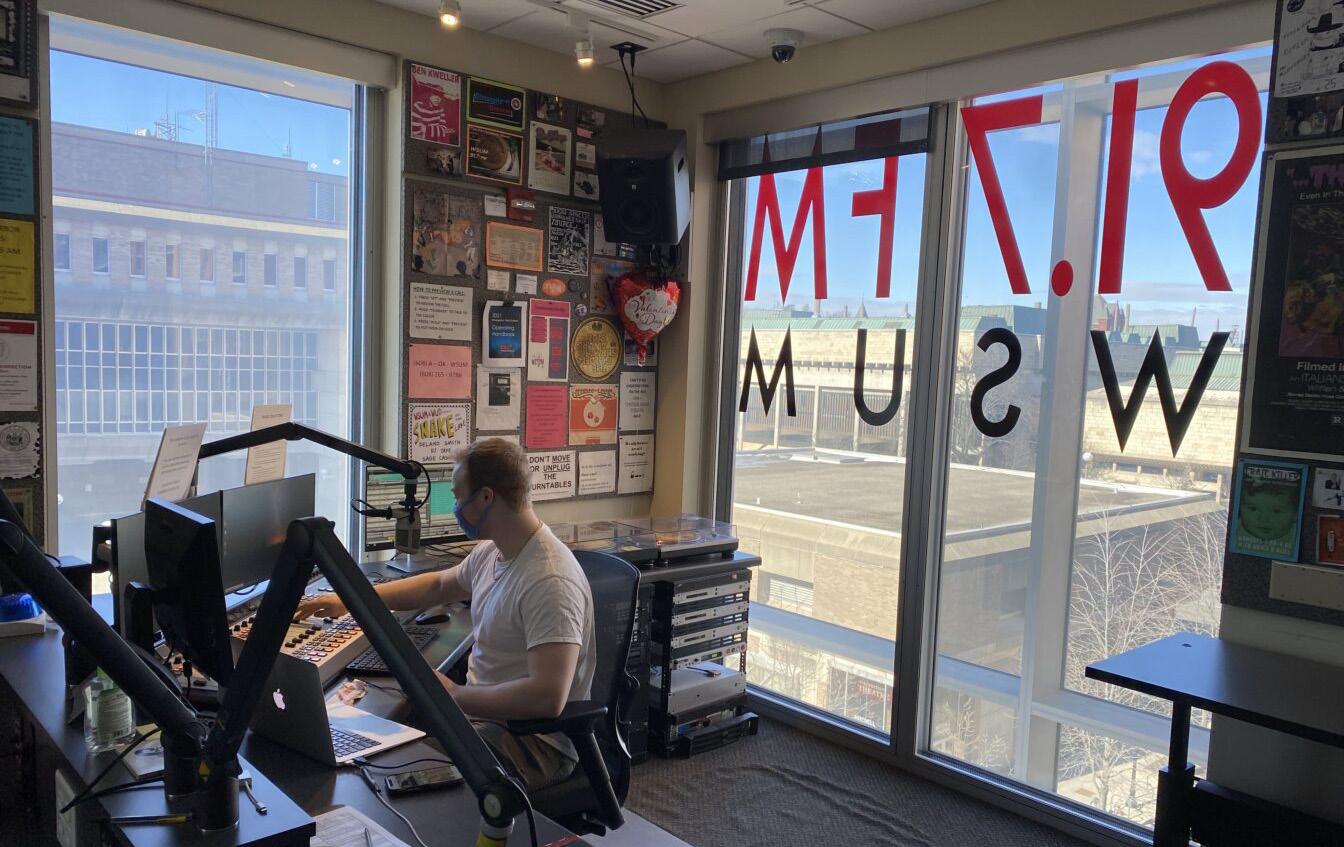
Artist and album graphics collaged the walls, with posters promoting student shows and upcoming events. With a large view of Lake Mendota, the station felt like home for some students. But something, rather, someone, was missing — Dave Black.
The cofounder and general manager of WSUM 91.7 passed away this February at the age of 66. For almost 30 years, Black and WSUM were two synonymous words, according to a Cap Times article.
“He was WSUM,” WSUM alum and former station manager Lorenza Zebell said. “He really worked for a long time to get WSUM started. It’s his legacy. It’s an amazing place, and I think his welcoming energy really extended to the test of the programming there.”
Back in 1993, the station, then known as WLHA, was taken off the air by the Federal Communications Commission due to interfering with existing radio signals, according to The Cap Times. At the time, Black was a journalism graduate student when the station reached out asking for help getting back on the air.
Mentee of Black and current director of the station Kelsey Brannon explained just how passionate Black was about getting the students back on the air.
“The group of undergrad students who were working on it … really wanted to keep it going, and [Black] took that desire that they had to
have a voice on the airwaves seriously and invested in it,” Brannon said.
And it wasn’t easy. It took Black eight years to get the station live again. There were legal battles with the FCC regarding getting a license and then getting a tower, studio space and funding, explained Brannon. During this time, Black was able to inspire two generations of students, who weren’t going to be able to be on the radio, to help build the station for future students. The station moved into its current space on the fourth floor of the Student Activity Center, in the 2007-2008 school year, Brannon said.
“He worked with the contractor to design the space specifically to be a radio station,” Brannon said. “The station as a whole, as a concept, wouldn’t really exist without him and this physical space wouldn’t exist without him.”
The station has a few unique features that demonstrate just how dedicated Black was about making it a learning and professional environment for aspiring radio personalities. The space contains a few small recording booths that allow the DJs to practice their shows beforehand, as well as a mock studio that replicates that real one, that allows students to train each other for going on the air.
His impact goes far beyond the physical space. Both Brannon and Zebell commented on his ability to make WSUM a welcoming environment.
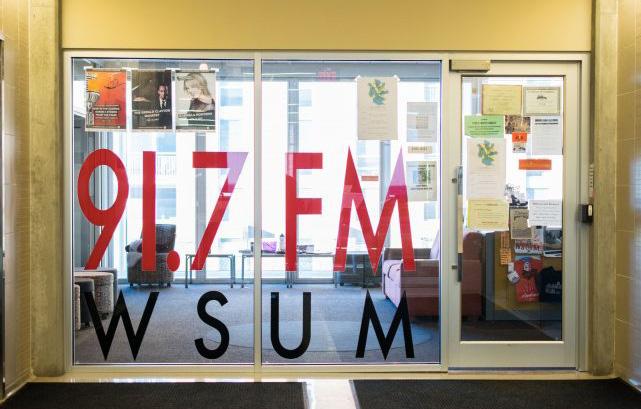
Most college radio stations are exclusive, with only juniors and seniors being allowed on the air. But WSUM allows students of all years to participate, making it unique, according to Zebell.
“It’s just really an open space for anyone, you don’t have to be in a program that is associated with media or communications to be involved,” Zebell said.
Black believed in making the space a place for educational opportunities.
“He wanted it to be used as an asset to the campus and to the community,” said Brannon, providing all areas of campus with a helpful and collaborative station.
Black played a large role in helping students come into their own. Zebell shared a story about how she went from feeling lost at UW to becoming the station’s manager.
In college, Zebell was a shy student, struggling to find her place in her degree program. WSUM and Black helped her come out of her shell. But it wasn’t easy at first.
“I started as a DJ my freshman year and I could barely even talk on the air. I was so shy. I remember when someone called in and they were like ‘It’s okay, don’t be nervous,’” Zebell said.
Yet, she stuck with it, thanks to Black’s mentorship.
“Dave really believed in me, he made me believe in myself,” Zebell said. “His mentorship really brought me out of my shell and made me a great DJ, a better writer for radio copy… and eventually, made me a leader.”
Her story is not uncommon, and Black impacted almost every student who walked into the station. Zebell explained that it would be hard to be involved at the station and not be touched by Black. Brannon shared a similar
story. When it came to her second year at the station, Brannon reapplied for the position of Traffic Director, where, like the name, you help direct the flow coming in and out of the station. But Black saw the bigger picture for Brannon and pushed her to apply for Program Director.
“Dave was persistent, and when things didn’t work out with the program director that was hired, I moved into that role, and he really encouraged me and bolstered my confidence that I could do the job,” Brannon said.
His guiding nature never left Brannon, even after she graduated. He remained a valuable resource for her, calling him countless times for advice. It was Black who encouraged Brannon to take over as general manager upon his retirement in Sept. 2021.
Brannon explained that she feels she was built in his image, taking his wisdom with her into the position. She hopes to continue to be a strong supporting resource for her team, as well as a safety net for when things don’t work out.
Zebell spoke highly of Brannon.
“She’s a rockstar,” Zebell said. “She’s going to really shepherd the station into a new era.”
Brannon has high hopes for the station in Black’s absence — she knows his legacy will continue on.
“It’s grown and evolved and changed since 20 years who when it went on the air, and it’s gonna continue to do that,” Brannon said. “Dave would really want that, he would want it to continue to grow and evolve and change, but all of that is happening on the foundation that he built.”
‘The station as a whole wouldn’t really exist without him and this physical space wouldn’t exist without him,’ Black’s mentee says
The University of Wisconsin’s School of Education launched its Teacher Pledge Program to combat the current shortage of teachers in the country and state.
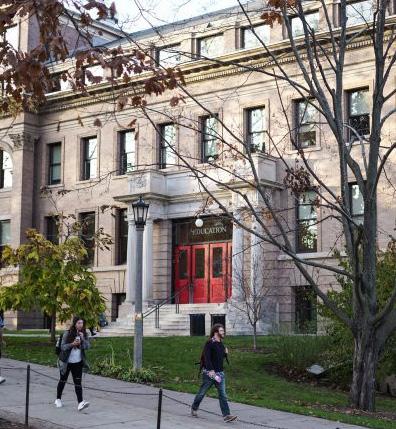
The pledge is part of Impact 2030, which uses donor funds to promote research and creativity within the school and beyond.
Launched in the summer of 2020, the program pledges to provide financial support — including in-state tuition, fees, and testing certification costs — for students enrolled in one of the School’s teacher education programs, according to the Teacher Pledge website.
In return, students teach for three to four years at a pre-K through 12th-grade school in Wisconsin after graduation.
Students who go on to teach in a highneed district or in a high-need subject area will fulfill their obligation in three years, while all others will do so in four, according to SoE Communications Associate Director, Todd Finkelmeyer.
High-need subject areas are defined annually by the Wisconsin Department of Instruction.
These subject areas include bilingual education, special education, mathematics, reading and more.
High-need qualifying schools, in Wisconsin, Title I districts, are defined annually by the US Department of Education Office of Federal Aid.
The Teacher Pledge program comes at a time when the U.S. is experiencing a teacher shortage and having difficulties filling classrooms, according to data released by the U.S. Department of Education.
The teacher shortage affected every state in the country during the 2017-2018 school year, according to this data.
The COVID-19 pandemic has exacerbated the impact of the teacher shortage, with challenges caused by online learning and quarantine periods.
While there are many factors that have contributed to the development of this teacher shortage, some of the primary contributors include high rates of retirement from educators of the babyboom generation, declining interest in an education career among students and high rates of teacher turnover, according to National University.
Given that UW’s Teacher Pledge program is new, the university is researching its effectiveness and will be sharing key findings to help aid efforts across the nation in strengthening the teacher workforce,
Finkelmeyer said.
According to some students in the School of Education, the Teacher Pledge has significantly contributed to the betterment of their experiences.
Camryn Booms, who is pursuing a masters degree in the Department of
Being from Michigan, Booms would have to pay out-of-state tuition for her program at UW — if it weren’t for the Teacher Pledge, she said.
According to the Bursar’s Office, out-ofstate tuition is nearly double the price of instate tuition for Booms’ program.
degree in Early Childhood Elementary Education and is expected to graduate in the spring of 2023, has also reaped the financial benefits of the Teacher Pledge.
By having her tuition covered for her junior and senior years, Cataggatan can relieve her family of this financial burden.
Cataggatan was inspired to become an educator because of her own positive experiences with teachers as a student.
Her identity as an Asian-American woman has also played a role in her desire to become a teacher.
“Representation in the classroom has a major impact on students,” Cataggatan said. “I didn’t have that representation and I take a lot of pride in my cultural identity, so I want to be that figure for my students who are either Filipino or also Asian American.”
A study by the Learning Policy Institute found that representation for Black people, Indigenous people and people of color in teaching helps boost the academic performance in BIPOC students.
According to the study, this representation can help improve reading and math test scores and graduation rates among these students.
According to the study, maintaining this representation can be difficult, given the lack of ongoing support new teachers sometimes experience. This in turn is driving high turnover rates.
Cataggatan said the Teacher Pledge not only has an impact on her but on the field of education in general.
With the Teacher Pledge, students are ensured that their tuition funds are being covered and schools are being ensured that future educators will be there, Cataggatan said.
“Those who are donating clearly see the importance of educators to the future,” Cataggatan said. “That money helps me have the proper materials, learning experiences and training that I need to be a supportive teacher in the future and so that I can make an impact on my future students.”
Curriculum and Instruction, previously earned a B.S. in Biology and Psychology from Ferris State University in Michigan.
If it weren’t for the Teacher Pledge and the financial support it provides, Booms would not have considered attending UW.
“I knew I wanted to go to a bigger university for my postgraduate education and was looking around at different programs, trying to find the best one for me,” Booms said. “When I found out about the Teacher Pledge, I knew Wisconsin was the best fit.”
The financial support of the Teacher Pledge coupled with supplementary School of Education scholarships made Booms’ cost of attendance comparable to what it would have been if she had attended a university in Michigan.
“Knowing that I won’t have any debt from this program and that everything was very nicely set up is a big stress reliever,” Booms said. “I can ultimately go into the field of teaching and not have to worry about paying student loans.”
Trixie Cataggatan, who is pursuing a
Cataggatan said the Teacher Pledge also helps with acknowledging the field of teaching in general.
Though central to every profession, teaching is often overlooked, she said.
As the U.S. continues to grapple with strategies to address the teacher shortage, programs such as the Teacher Pledge may prove to be effective in addressing this situation.
UW will report on the effectiveness of the Teacher Pledge in the future, according to Finkelmeyer.
‘I would not have come to Wisconsin if it weren’t for the TeacherPledge program,’ UW student, aspiring educator says Photo - The program provides financial support for students enrolled in School of Education teaching programs Marissa Haegele The Badger Herald
‘Don’t Say Gay’ bill, new Wisconson
by Ethan Farrell ReporterA vocal group of around 60 people gathered with signs and megaphones at the Capitol to voice their concerns Feb. 17 against Senate Bill 915.
The bill would bar physicians and healthcare providers from administering any gender transition procedure for individuals under the age of 18.
The bill defines such procedures as “any physician’s service, inpatient and outpatient hospital service, puberty blocking drug, cross-sex hormone, genital gender reassignment surgery, or nongenital gender reassignment surgery.”
The bill is an attack on trans youth, according to organizer and activist for gender expansive rights Amira Pierotti.

“All of the mythology that comes out of [saying] ‘Trans youth aren’t able to make these decisions for themselves’ is based on transphobia … even though it may not have malintent, this misunderstanding is very costly,” Pierotti said.

The Badger Herald reached out to Senators André Jacque, R-DePere, and Kathleen Bernier, R-Chippewa Falls — two of the representatives who introduced the bill Feb. 1 — but neither office responded to requests for comment.
The Herald also contacted the University of Wisconsin’s Gender and Sexuality Campus Center’s Program Coordinator Whitney Anderson, who said the GSCC is
unable to comment on pending legislation.
The legislation comes as a late ripple in the larger wave of similar bills that swept across the U.S. in 2021.
That year saw 23 bills regarding the restriction of transitional healthcare for youth across 16 states.
Until now, two bills have been introduced, 14 are still in committee, one has passed through its state’s senate and four are currently dead in the water.
The only one of these bills to have made it all the way through its state legislature was Arkansas HB 1750 in March of 2021.
What makes WI SB 915 particularly noteworthy in comparison to others is its wide-sweeping definition of gender transitional procedures.
It includes psychiatric care and counseling as a form of social transitioning, meaning these would also be off limits and physicians could be subject to legal punishment for administering them.
The bill also forgoes the ability of a parental guardian’s consent to override the law’s restrictions.
The bill would need to be signed by Gov. Tony Evers, who vocally opposed bills that would ban transgender youth athletes from competing in girls sports in May 2021.
“I very seldom think about a veto before I actually see the bills, but anytime we decide to take a certain group of kids and prevent them from reaching their full potential, that’s a problem,” Evers said, according to Channel3000.
In 2019, the American Academy of Child and Adolescent Psychiatry published a statement in support of the use of current evidence-based clinical care with people under 18.
AACAP also stated they oppose any attempt to block access to such interventions.
Supporters of bills like SB 915 often cite de-transitioning — the decision later in life to reverse the procedures they had undergone previously to return to their assigned gender — as a concern for youth who are seeking medical gender transition.
Arkansas representative Robin Lundstrum was the lead sponsor for AR HB 1570, which passed in 2021.
“These kids deserve to be loved and cherished, and let’s let them wait until they are 18 until they make a serious decision that they can’t take back,” Lundstrum said in a statement.
In a 2015 survey by the National Center for Transgender Equality, over 90% of the 28,000 transgender respondents said they had not de-transitioned in any capacity.
A different 50-year survey released in 2010 revealed that roughly 2% of the 767 transgender participants regretted undergoing gender-affirming surgery in Sweden.
One such solution to transitioning before someone may be ready to do so are puberty blockers, which place the changes a person goes through during puberty on pause, often giving time for individuals and their families to weigh their options as well generally improving mental health for those taking them.
SB 915 would also ban the prescription of puberty blockers, something Pierotti has been keen to point out as counterintuitive.
Despite the continued push by some representatives to limit options for trans youth and by-passers walking directly through their protest, Pierotti came away feeling empowered afterward and optimistic about the future.
“It doesn’t have to be like this,” Pierotti said. “I’m a trans youth, I’m very much happy to sit down with anyone to explain this because shouting at each other isn’t working.”
The Polar Radiant Energy in the Far InfraRed Experiment — or PREFIRE — team at the University of Wisconsin is collaborating with NASA’s Jet Propulsion Laboratory to get a better understanding of far-infrared radiation’s impacts on the Arctic’s climate.
PREFIRE will launch two small satellites the size of cereal boxes, called CubeSats, to measure far-infrared radiation over Earth, principal investigator at PREFIRE and director of the Cooperative Institute for Meteorological Studies Tristan L’Ecuyer said.
Far-infrared radiation has never been systematically collected on Earth before, according to L’Ecuyer. But, L’Ecuyer said measuring far-infrared radiation will give scientists new information about emissivity, or how much energy the surface of the earth absorbs and emits. The data will also provide more information about water vapor and clouds — especially ice clouds.
“There’s excitement in the fact that we’ll be able to do better climate predictions, we know that,” L’Ecuyer said. “But there’s also excitement in just looking at the data and seeing something completely new that we’ve never seen before
... What new things that we’ve never even thought of will we be able to learn from these measurements?”
Far-infrared radiation on Earth has only been measured from space once — L’Ecuyer said data was collected for a couple of days in the 1970s, and some researchers have made a few ground measurements. L’Ecuyer said he hopes PREFIRE’s CubeSats will remain in orbit for over one year.
The Earth’s atmosphere balances the energy it receives from the sun by emitting infrared radiation back into space, L’Ecuyer said. In the past, scientists have only measured about half of the spectrum of Earth’s infrared emissions, but L’Ecuyer said PREFIRE will measure the other half.
Several groups of UW researchers will be able to use the new data collected by the PREFIRE mission. L’Ecuyer said the data will be useful for the Antarctic Meteorological Research Center, the Department of Geoscience, the Atmospheric Science Department and many others to improve the research of sea ice, melting glaciers, clouds, water vapor, energy balance, climate modeling and climate forecasting.
L’Ecuyer said he’s also working with NASA to send students on a field campaign in the Arctic to verify the CubeSats’ measurements and perform some fieldwork.
“More than half of our team right now is made up of students,” L’Ecuyer said. “They’re involved in the calibration of the instrument, they’re involved in predicting what our measurements are going to tell us about clouds and about water vapor and [they’re] actually developing the algorithms that will eventually create the products from this.”
One of these students is Meredith Grames, a third-year graduate student studying atmospheric science with a focus in atmospheric radiation and remote sensing. Grames is working with the atmospheric retrieval group to develop an algorithm to retrieve temperature and water vapor data from the CubeSats’ measurements.
“Everything about this mission has been a learning experience, which I think has been fun,” Grames said. “As a student learning the whole process of what goes into a satellite mission has been really fascinating.”
One of the main challenges in Grames’ work is figuring out how to write an algorithm to visualize measurements that haven’t been taken before. L’Ecuyer said a challenge for the mission as a whole has been configuring the technology to fit on a CubeSat, which runs on less power than a lightbulb and has to transmit data from space to Earth.
The Jet Propulsion Lab and Blue Canyon
Technologies are working to engineer the CubeSat, and L’Ecuyer said they have made the technology very reliable. The satellite should operate with power for at least a year, but it could potentially provide the team with data for up to four years.
The Jet Propulsion Lab is building the instrument that will measure far-infrared radiation, along with Oxford University and a company in California. L’Ecuyer said that once the Jet Propulsion Lab finalizes the measuring instrument, they will send it to Blue Canyon Technologies. Blue Canyon Technologies is building the CubeSat, which will be shipped to a launch site in the U.S. to be put into orbit.
UW is working on the science behind the mission, L’Ecuyer said, which includes performing data analysis and developing algorithms to interpret the data. While the main focus of the project is on the Arctic, L’Ecuyer said the data could allow researchers to see things they’ve never studied before all over the globe.
“I think what’s super exciting is just looking, we’re going to see things that we never expected to see in these measurements and it might not even be in the poles,” L’Ecuyer said. “It might be in the tropics, or might be over the U.S. or somewhere out over in the middle of the ocean.”
Read the full story online at badgerherald.com
Despite challenges and months of setbacks, a team of students at the University of Wisconsin placed 17th out of 117 at the International Collegiate Programming Contest world finals.
October 2021, three UW students traveled to Moscow to compete in the team programming competition. The ICPC is the oldest, biggest and most prestigious programming contest in the world.
The 2020 world team included Ziyi Zhang, Jirayu Burapacheep and Nitit Jongsawatsataporn, who substituted for Dung Viet Bui in the world finals. According to a UW press release, they continued the team’s 20-year streak at the ICPC world finals, the only team in North America with the title. UW Computer Sciences Professor Dieter van Melkebeek has been UW’s ICPC team coach for all 20 years.
The team that traveled to Moscow competed in the regional competition in fall 2019, which they won by solving 10 problems when no other team solved more than seven. They advanced to the North American Championship in Atlanta, Georgia where they qualified for the world championship, according to the team’s website.
Unlike other programming competitions, which are often individual, students competing in the ICPC work in teams of three, van Melkebeek said.
Teams have five hours to solve as many problems as possible.
Van Melkebeek said teams are given a series of problem statements with a story behind them. The problems all have an algorithmic or mathematical component, and the team needs to develop a plan to solve the problem and write the computer code to implement it.
“We have a three-person team and one computer,” Zhang said. “One thing we try and optimize is the time on the computer. It should be as [short] as possible. We might need to sketch out what type of thing to code before we type it on the computer.”
Once a team thinks they have a solution, an automated judge tests the program and checks if the result is correct. The program should run in the allotted time without using too much memory space. If there is an error the team can try again, but they get a time penalty, van Melkebeek said.The best a UW team has ever placed was 11th out of 68 teams during the 2001-2002 season. But van Melkebeek thinks the Moscow team was one of the strongest.
“The competitiveness of this competition has gone up a lot,” van Melkebeek said.
According to van Melkebeek, now the top teams are almost professionals and the students on them compete a lot more. Here at UW, the team attracts many top students, but they’re still not a
professional team. Around 300,000 students from 111 countries are involved in the regional competitions each year, according to the ICPC website.
Zhang said the team goes through a 10-week training program where they meet and discuss problems to prepare for the competition each year. Every week, they focus on a specific problem area, such as computation geometry and dynamic programming. To put the students into teams, they each take an individual placement test.
“We want to strike a balance there, right,” van Melkebeek said. “We want to make sure our top team is very strong, but we also want it to be a nice experience for other students as well.”
The world finals in Moscow were scheduled for June 2020, but organizers had to postpone them due to the COVID-19 pandemic. The world finals were finally rescheduled for November 2021.
The team usually had three months to prepare for the world finals, but this meant they had 18 months to prepare instead. According to Zhang, practicing became difficult because members of the team were in different time zones.
While the team continued preparing, multiple other roadblocks came up. Normally, the travel funds are funneled through the university, but UW deemed the trip nonessential because of the pandemic. Van Melkebeek appealed the decision, but UW didn’t change their ruling, so the team
decided to pay for their own travel expenses.
The team also found out Viet Bui, who competed with the team at the regional and North American competition, could not travel to Moscow due to visa issues. While he could leave the U.S., he would have been unable to reenter the country.
Viet Bui let Jongsawatsataporn step in shortly before the world finals. At this point, the team had been practicing for almost 17 months, and Jongsawatsataporn had about a month to prepare with the team. Normally, no substitutions are allowed once the team qualifies, but the organizers allowed it due to the circumstances, van Melkebeek said. With recent competitions and training all moved online, the world finals were a chance for the team to catch up with other competitors.
“We ended up meeting a lot of people from both U.S. and outside U.S.,” Zhang said. “This is really great because so far we just meet online.”
The organizers wanted the competition to remain in person to protect its integrity, according to van Melkebeek. It’s a unique atmosphere with teams from all over the world.This year’s teams competed in the regional competition Feb. 26. Van Melkebeek is optimistic because this year he thinks they have an even stronger team.
“You’re working with students who are really motivated,” van Melkebeek said. “They don’t have to take this, it is because they want to do it.”
Given far-infrared radiation has never been sytematically measured, project may prompt new discoveries, research, student involvement

Editor’s note: The Lab Report is a weekly series in The Badger Herald’s print edition where we take a deep dive into the (research) lives of students and professors outside the classroom
The Maeda Lab at the University of Wisconsin is researching amino acids in plants to find new solutions for the production of natural and bioproducts like medicine.

According to the lab’s website, aromatic amino acids impact plant growth and the nutritional qualities of crops. Megan Gundrum, a senior in the lab studying chemical engineering, said if the lab finds a plant that produces large amounts of medicinal compounds, it could be used to produce new types of medicine.
“I think finding a natural source is better than having it be made synthetically,” Gundrum said. “These plants that I’ve been studying at least have been used for centuries as medicinal plants by different cultures around the world. And, why not use the knowledge we already have from that to help other people?”

Andrew Hall, a senior in the Maeda Lab studying biochemistry and Spanish, said one of the larger goals of the lab is studying how enzymes evolved to have different functions. They also research how enzymes respond to amino acids.
One of the amino acids found in plants is called tyrosine. Tyrosine is a precursor molecule to a variety of metabolites with assorted physiological
functions in plants, according to a paper in the journal Phytochemistry. Some of these have a history of use in human medicine and nutrition.
Hall’s senior thesis investigates the biochemical characteristics of enzymes that are involved in the production of tyrosine. The goal of his research is to clone the gene sequences coding for these enzymes, place them into bacteria for reproduction and purify them from the bacteria.
To begin his research, Hall tried to express enzymes in E. coli. The biochemistry of E. coli isn’t adaptable to plants, Hall said, so his next step was to use plant pathogens on tobacco plants. After, he moved on to express enzymes in tobacco leaves and purify proteins using the plant tissue.
Gundrum began her work in the lab studying tyrosine, too. The research project she started with studied two orders of plants to find species that produced high amounts of tyrosine and find their evolutionary relationship. Most of her work involved collecting tissue, Gundrum said.
One of the projects Gundrum is currently working on is creating a database to show the chemical compounds produced by different species of plants. The original information about each plant was gathered from the internet, Gundrum said, but her job is to make sure the information is true by collecting tissue samples and running tests.
Gundrum is also growing her own plants. After the plants grow, Gundrum said she’ll collect their tissue and extract chemicals to test for chemical compounds like tyrosine.
One of Gundrum’s favorite parts about working in the Maeda Lab is working in the greenhouse, planting her own plants and collecting plant tissue for the lab’s research. Another highlight of the lab for Gundrum is community outreach — Gundrum said the lab teaches children about plant science through events held on campus.
Reflecting on their time spent researching, Hall and Gundrum highlighted the camaraderie in the Maeda Lab — members of the lab participate in activities together outside of work and form friendships that make the lab more fun to work in.
“I think that one of the things that’s really special is that everyone in the lab is very friendly and very helpful, and we all support each other and do a lot of fun activities together outside of the lab as well,” Gundrum said. “It’s kind of like a big group of friends all working in the lab together.”
In the future, Gundrum said she hopes to get a Master’s degree and work in a lab as a chemist or as a research and development engineer focusing on environmental chemistry. Working in the Maeda Lab taught Gundrum to independently plan her own projects and experiments as well as communicate her research with other people.
Hall said he’s always been interested in plants
but when he initially searched for research labs, he didn’t know what he wanted to study. He chose to work in the Maeda Lab after his time in the Biocore program, where one lab investigated plant genetics. Hall is most interested in the evolution of plant metabolism over time.
The most valuable thing Hall learned in the
Maeda Lab is that there are often problems when performing research, but troubleshooting is part of the process.
“I learned a lot about plant metabolism, for sure,” Hall said. “But I think more importantly, research really doesn’t work out a lot of the time and you have to kind of accept that.”

shows augmented reality makes tasks easier, but decreases learning, continuous improvement in manufacturing
by Scott McInerney Science News EditorWith growing technological advancements driving the progress of virtual reality and augmented reality, a recent study observed behavioral impacts in the applications of AR in a manufacturing setting.
Professor of operations and information management Enno Siemsen co-authored the paper. He said the goal of the study was to observe how AR changes the nature of work for people in manufacturing.
“I knew that there were clear benefits to using the technology,” Siemsen said. “But every time you go on a project like this you also want to understand what are the possible drawbacks, right?”
The study was conducted in a German manufacturing company, where they tested workers’ speed in performing new tasks with and without the aid of AR instructions. Siemsen said they found that workers who used AR support were more productive than those using traditional printed instruction. But, when the researchers removed the instructions those who used AR struggled to continue with the task compared to others.
Another important aspect of the study was the concept of process improvement. People using
AR instructions could not provide beneficial input for improving manufacturing processes, Siemsen said, while the printed instructions group came up with constructive feedback immediately.
“This experiment suggests that, in terms of sort of innovation and continuous improvement to the process, you’ll suffer if you don’t implement augmented reality in a smart way,” Siemsen said.

The study was only conducted over a short period of time, but it hints at the potential longterm behavioral effects of AR. Siemens said possible ways of overcoming the innovation and learning drawbacks of AR in manufacturing could be limited use of the tech within a team or programming AR as learning devices rather than a means of step-by-step instructions.
Siemsen pointed to a phenomenon called the productivity dilemma, in which learning about a process decreases as that process becomes more standardized for immediate efficiency. One example of this can be seen in GPS navigation, where step-by-step instructions for a journey don’t allow the user to build the mental model they would create when using a map to navigate themselves, according to Siemsen.
“Industry 4.0 is all about digitization and bringing in technology and so on,” Siemsen said. “But ultimately, it will never entirely replace human beings in the workforce, and we really want to make sure that the ingenuity of a frontline worker’s creativity and their potential is still there and still a key element of every sort of manufacturing process.”
Siemsen said the study is not trying to say not to use AR technology, but rather to be cautious and aware of how this technology interacts with the people that use it.
Using print instructions reduces the time it takes to complete a task the more it’s done — this is called the power law of learning. But using AR instructions causes people to get worse at the task when the instructions are removed, Siemsen said, which shows rare evidence of breaking the learning curve.
“It demonstrates how strong the effect is,” Siemsen said. “That this is not a trivial small, kind of effect that would just wash out with a learning curve. It’s a pretty strong effect, so I don’t celebrate this as a good thing. I celebrate this as an unusual empirical phenomenon — you usually don’t break the learning curve.”
AR technology can be applied to other fields as well, Siemsen said, and this study serves as a cautionary tale. In settings like the medical field, it could be dangerous to rely on step-by-step instructions.
Graduate student Jingjie Li works in the Wisconsin Embedded Systems and Computing Lab with a focus on privacy and security. A current project at WISEST is a medical application of AR called readyVue.
Li said readyVue is looking to expand on current products that can be used in surgery
training to give information on human organs of interest.
One implication to consider in VR and AR technology is privacy, Li said, as these devices can collect biometric data of the user as well as the environment and surroundings. This leaves room for sensitive information to be stored and sold to unwanted third parties for advertisement — especially in medical settings.
Li is working to give users a means of control over what data collected by AR and VR technology is secure. With advanced technology, biometric and environmental data can be used to infer personality traits or emotions.
“The malicious party could also use these techniques to exploit private attributes that weren’t revealed in the previous old days,” Li said. “This is something important for our research as well. To nudge the user — to inform them of this privacy risk before addressing them.”
Li said his angle of research is aiming to give a generalizable framework for privacy in AR for all sorts of scenarios, like gaming or healthcare.
While VR and AR have been around for a while, the advancement of this technology is leading to a variety of applications. No matter the setting, researchers are working to see potential tradeoffs as more and more people use this technology. Whether its privacy or behavioral implications, studying the drawbacks of this technology will be important before the widespread adoption of mixed reality both researchers’ work shows.
Note: This article uses person-first language (“people with disabilities”) and identityfirst language (“disabled people”) interchangeably, per the mixed use in various interviews. It should be noted that people may prefer either term or different terms.
One day in fall 1994, University of Wisconsin law student Brigid McGuire rolled up to a desk, revved up an electric saw and cut it in half to make room for her motorized wheelchair.
This moment was the final straw for McGuire after she had received nine parking tickets in one semester. Her offense — the inability to find parking close enough to the law building to accommodate her disability. At one point, an assistant dean had McGuire arrested for trying to prevent her car from being towed after parking in the grass on Bascom Hill during construction.
McGuire’s struggle and act of defiance came four years after March 1990, when hundreds of disability rights activists abandoned their mobility aids to pull and drag their bodies up the steps of the U.S. Capitol to bring awareness to the need for legislation ensuring access for people with all kinds of disabilities.
This protest, known as the Capitol Crawl, inspired the landmark Americans with Disabilities Act to be signed into law in July 1990.
The ADA is known as a critical moment for disability civil rights law, and the realm of higher education, this means that students, staff and faculty are entitled to accommodations that facilitate full
Though the ADA can provide countless accommodations to the UW campus community, McGuire’s story shows it doesn’t mean they always get them. Today, the McBurney Disability Resource Center holds a crucial and appreciated role in securing such access for students with disabilities, however, McBurney only addresses a handful of the issues faced by disabled students, staff and faculty on
Following the footsteps of McGuire and the Capitol Crawl protesters, UW students and employees in the disabled community are continuing the fight for further recognition and inclusion on
who thinks they may be in need of extra support in the classroom may apply for McBurney’s services. A common misconception is that one must have an official diagnosis before applying for accommodations.

After submitting an accommodation application, students meet with an assigned access consultant who evaluates how to make the educational or housing environment most accessible for them.
Magler said the initial meeting is the most important, as it is when the McBurney Center gets to know the student in general, in addition to what barriers exist for them on campus.
“Disability is not a fault that lies with us individually. It is a thing that exists because of how the environment is created,” Magler said. “Let’s focus on the environment and not the person, if we can.”
Once a student has been approved for accommodations, they can go into their McBurney Connect online portal each semester and choose which accommodations they would like for each class, so they can tailor their accommodations to meet the specific demands of different courses, Magler said.
After selecting class accommodations, the portal generates a Faculty Notification Letter, which is sent to instructors at the beginning of the semester. Students are encouraged to meet with each of their instructors to discuss everything as well.
But, ease of access to accommodations is not equal for all students seeking them, as administrative barriers and actual adoption by instructors create more hoops to jump through.
EDR to fully ensure an accessible experience at UW, it can be difficult to know where to go.
“[Grad students] play a lot o roles on campus, and I think it can be harder to navigate those roles when you have a disability,” Amy said.
UW sociology graduate student and teaching assistant Sara Trongone has an autoimmune disease and takes medication that makes her immunocompromised. Prior to the pandemic, she said she didn’t have any issues with asking for time off for transfusion appointments. But the pandemic has changed the scope of her access needs.
Trongone wanted to teach remotely for the fall 2021 semester, but after conversations with her disability representative and friends who were being denied or ignored, she felt discouraged from pursuing an official request.
“When I talked to a [representative] from the disability and accommodations office for the university, they just sort of said, ‘No one is getting accommodations,’” Trongone said. “At this point the university’s made it pretty clear … that what makes the university money is satisfied students, and most students seem to want to be in a
accommodations, but it does require more documentation to fully understand the barriers presented by in-person instruction.
For faculty, course modality is set by individual departments based on what modality will fit effectively with the course, according to UW spokesperson Meredith McGlone. Faculty accommodations, COVID-19-related and not, are determined and approved on an individual basis. Even without a pandemic, many individuals still face a vast bureaucracy if they encounter challenges with their accommodations.
While the McBurney Center often successfully approves students’ appropriate and documented accommodations, the rest of campus is not always on the same page.
UW sophomore Priyanka Guptasarma said she sometimes spends a lot of energy just communicating how to work out her accommodations with instructors, particularly in her STEM classes.
“If a professor says no, you reach out to McBurney to help you, and then the professor responds, and then you have to respond and it’s almost like a three-credit course every semester is just getting accommodations,” Guptasarma said.
accommodations — but proper access to accommodations is just the start of improving disability inclusion on campus.
When Magler worked for University of Minnesota’s disability office, she remembers a conversation with a blind student who said to her, “I might have the total access I need in class, but if nobody comes and sits by me and asks me how my weekend was or asks me to lunch, I don’t have inclusion.”
UW students and staff echo that sentiment — in order for disabled people to be fully welcomed on campus, the campus has to reshape how it thinks about access and disability more broadly.
In her ideal world, Bille said access means a complete elimination of physical and social barriers while awarding students with disabilities the exact same freedoms as nondisabled people.
“There are so many lecture halls where you are stuck either in the first row or the absolute back row if you have any sort of mobility contingencies,” Bille said. “If I need to use my wheelchair I should [not have to be] constrained to the front row or the back row.”

to engage in raising awareness on disability-related issues, listen to guest speakers and support each other.
“We definitely have just had meetings where it’s a vent session [and] we talk about frustrations we might have about accessibility on campus or complications people have had with McBurney accommodations,” Bille said.
Similarly Amy founded the organization BadgerSTART as a way for all UW students to find connections with each other and advocate for issues facing the community. She is hoping to rebrand BadgerSTART to be a part of a national organization called Disability Rights, Education, Activism and Mentoring, known as DREAM.
Other ways students with disabilities have found ways to connect are specialized groups such as Chronic Health Allies Mentorship Program, also called CHAMP, Law Students with Disabilities Coalition and Disability Advocacy Coalition in Medicine.
Where other students are banned from using laptops in classes or certain elevators on campus, UW senior Justin Myrah has access thanks to the McBurney Center. Myrah, who has hemiplegic cerebral palsy, can use a laptop to take notes even if instructors have policies against technology and can use elevators otherwise closed to
Students themselves are the ones who know their access needs best, but the McBurney Center is the main avenue to adequately meet those needs through university-provided accommodations.
“I basically just told [McBurney] everything that I needed, and they were like ‘okay,’” Myrah said. “They even made more suggestions for me … [things] that hadn’t even crossed my mind.”
According to its website, the McBurney Center serves approximately 4,000 students who have been determined eligible for accommodations. These accommodations range from extra testing time and flexible deadlines to having an accessible shower in
McBurney Center Director Mari Magler assures that any student
UW graduate who finds herself created by the accommodations across campus. The Cente helps UW employees secure accommodations through an assigne representative respective college, Magler said. But since graduate students must work with both the McBurney Center and
Trongone is not the only UW employee who felt discouraged at the start of the academic year, as faculty members and others questioned some of the accommodations denied last semester. Thirtyone faculty members submitted accommodation requests, but only half of them were approved and one-third were still being processed less than a week before classes started.

Magler said remote learning has become a popular accommodation request for both students and faculty since the start of the pandemic. The process for students requesting remote learning is the same as other
For students, there are generally two grounds for which an instructor can deny accommodations. One is called a “fundamental alteration,” or when an accommodation would change the very nature of the class. In this case, Magler said the McBurney Center will work with the student, professor, department or academic advisor to either find an alternate class or work out an alternate accommodation.
The other is “undue burden,” which usually arises in the form of too high of a cost to implement an accommodation, but Magler said this is a relatively rare occurrence.
Students are not obligated to share a disability status, which could subject them to unwarranted medical questions or stigmatization.
UW sophomore Brelynn Bille stressed that students, particularly those with invisible disabilities, should not feel pressured to disclose anything besides their accommodations.
“[Sometimes] professors go way too far in terms of making students almost justify their accommodations, and they have absolutely no right to be doing that,” Bille said. “There’s definitely a huge disconnect with professors at times with what is and isn’t appropriate for them to be doing when they receive our Faculty Notification Letters.”
Should a student face challenges with a professor, Magler said they should get in touch with their McBurney access consultant. There is also a grievance policy and bias incident report form students can fill out to address the issue.
Myrah, Bille and Guptasarma said they believe faculty could use more training on how to both implement accommodations in their specific classes and interact with students who have
Myrah knows that not every person is going to want to discuss their individual disability and accommodations, and deciding whether or not to disclose a disability is a right. But he also believes having more open conversations about disabilities in general can minimize the stigmatization and othering of disability as a rare and personal phenomenon.
“[There’s] the idea that disability is a private issue, but disability isn’t a private issue, so faculty, professors [and] administrators need to quit treating it like one,” Myrah said. “The people I’ve talked to are disability-friendly but that doesn’t mean there’s a culture of disability [acceptance] on campus … because it’s just not talked about.”
Many hoped the pandemic and the adjustments made during it would expand people’s understanding of accommodations and access. But Trongone said it unfortunately seems like the pandemic is being treated as an inconvenience society needs to overcome rather than an opportunity to learn how to be flexible and accommodating to people with all types of different access needs.
When freshman Emmett Lockwood first stepped onto campus this past fall, he was excited to find a hub for queer students — the Gender and Sexuality Campus Center, also known as the GSCC, which serves as a way for many LGBTQ+ affiliates and organizations to connect with each other. His next question — whether there was a similar entity for the disability community.
Advocates for Diverse Abilities, or ADA Badgers, is a student organization for students with disabilities and allies to come together
These organizations sprinkled across campus undoubtedly serve a valuable purpose and show the resiliency disabled people have in building connections among one another But Lockwood and others point to an issue o mainstream lack of recognition of disabled identity which creates challenges in fostering a cohesive community
“Disability is an important part of identity, and I think it’s just really valuable for students to grow in that identity and also come together with those that have a shared identity,” Amy said. This collective desire for mainstream identity-based inclusion led Lockwood to use his internship with ASM to start coalition-building and create a Disabled Students Cultural Center, or the DSCC. After garnering support from clubs, the McBurney Center and fellow students, he is currently in the process o gaining approval from Associate Vice Chancellor for Student Affairs Gabe Javier to start the DSCC.
Lockwood envisions the DSCC functioning like the GSCC by bringing awareness to student organizations with shared goals, creating space for meetings, providing formal and informal mentorship and connecting students with resources, including the McBurney Center
“Once you get disabled people in a room together, once disabled people start talking to each other so many more ideas about how the university could do better arise,” Lockwood said.

Lockwood also believes the DSCC can bring more visibility and recognition of disability culture and community to campus, and having a physical space beyond an accommodations office would help solidify the disability community as a valid identity group with a voice in campus decisions.
This visibility would ideally encourage conversations about accessible education and celebrate disability identity and all the community has to offer
“Disability culture, from what I’ve seen, is always about meeting the other person where they’re at [and] making sure that you’re doing the best you can to be accessible,” Lockwood said. “It’s about accommodating each other and holding space for each other, but also finding joy in the aspects of us that many other people don’t know how to find joy in.”
Read the full story featuring an interview with GWS professor Sami Schalk online at badgerherald.com
“ “Once you get disabled people in a room together, once disabled people start talking to each other, so many more ideas about how the university could do better arise,”
Emmett Lockwood
Every winter, the University of Wisconsin Dance Department presents the Faculty Concert, where different professors in the department display their choreography in one collective show. Dance majors and students involved in dance studies have the opportunity to audition for different pieces, which they work on for the first semester of the school year.
The 2022 Faculty Concert had six different showings and wrapped up their final show Feb. 12. Every year the department invites a guest artist to audition and choreograph a piece on the dancers. This year, Natalie Desch set a piece that was choreographed by José Limón.
Natalie Desch is an assistant professor of dance at the University of Utah. She earned her BFA at The Juilliard School and her MFA at the University of Washington. She performed with the Limón Dance Company for five years and then spent another 11 years with Doug Varone and Dancers in NYC.
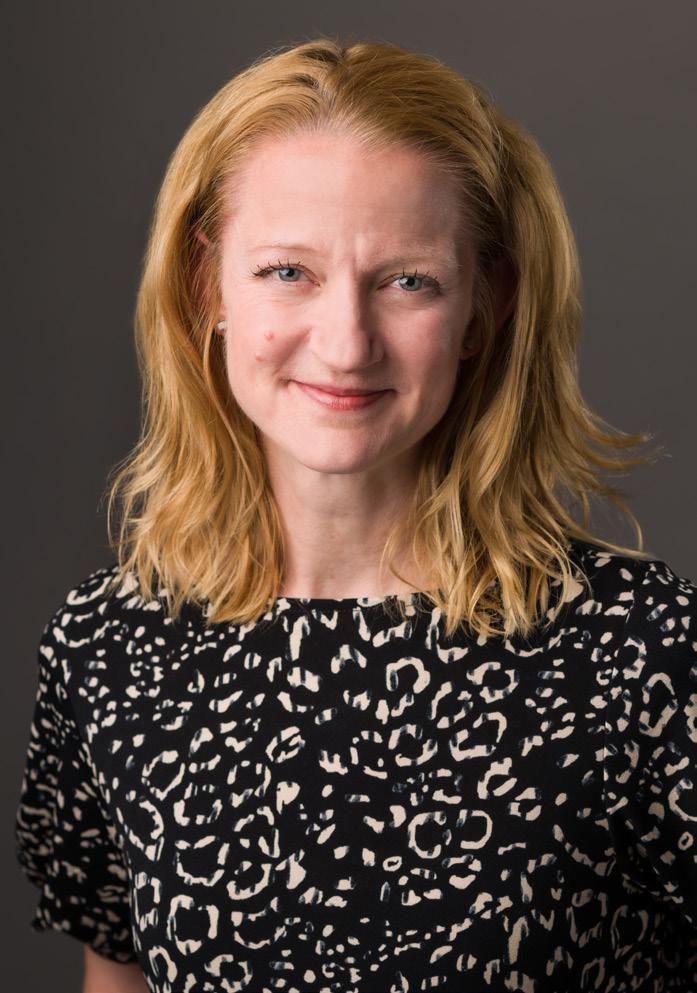
José Limón passed away in 1972. Though
Desch did not get to work with him directly, she learned his technique and values from professors and dancers who worked with Limón while he was alive.
“It was really, really amazing to have that transfer of information, through classes and watching, I mean, really watching,” Desch said. “Taking information through my personal perceptions was a huge learning experience.”
Desch emphasizes the importance of dance being shared and passed down through generations. After performing with the Limón Company for many years, she was able to set one of his pieces on the dancers here in Madison.
“I was tasked with a restaging of a Limón work, meaning that I’m charged with teaching the dance, but also making sure that the elements that surround and support the dance are in place to recreate the vision of the choreography,” Desch said. “It’s just a really exciting process to have the information in my body and share it physically with the dancers. That’s the most critical part — it is movement
that is shared.”
The piece is titled, “Dances for Isadora” and was first performed in 1971. The piece consists of five solos that reflect different stages of Isadora Duncan’s life. It has a theatrical and somewhat dramatic storyline, according to Desch.
“Her name was Isadora Duncan, a very formidable and very important person in dance history but more formally, in concert dance history,” Desch said. “This concert dance where we go to the theater, where we have an audience and spectators — it’s kind of its own genre that was very important to Isadora and also very important to Limón several decades later.”
In creating “Dances for Isadora,” Limón considered it as an homage to Isadora Duncan and her impact on modern dance. Duncan brought forth a new chapter in American dance by implementing new philosophies and breaking some ties with some Western European traditional dance, according to Desch.
UW presented “Dances for Isadora” as the final piece for every concert. The five solos were double-cast — meaning, 10 dancers were selected to perform Limóns work. The dancers had one week to learn the choreography and be ready to perform on stage.
Erin Walsh, a dance major at UW, worked with Natalie Desch and performed the solo titled “Maenad.’’ She enjoyed learning from Desch and being a part of the process.
“She’s probably like my favorite outside person I’ve ever worked with here,” Walsh said. “She is very good about being descriptive and detailed with her teachings and her choreography — overall a very positive influence and I loved working with her.”
Walsh has trained in many forms of dance and noticed how the Limón technique reassembled and differentiated from other modern teachings.
“I think the Limón technique is pretty similar to most modern techniques,” Walsh said. “It works with a lot of curves, carves and shaping. What I learned the most is his emphasis is on the work in the hands. A lot of your distal ends are emphasized whereas in other techniques the inner core is more emphasized.”
Natalie Desch continues the teachings of Limón through her detailed instruction. She helps students learn the quality of the movement as well as the history.
In between Isadora Duncan and José Limón, Desch mentioned a third artist named Doris Humphrey. After Duncan started breaking the rules of traditional dance,
Humphrey continued this investigation in her work, according to Desch.
This was the “investigation of movement that occurred between two axes,” Desch said.
As depicted in the graphic to the left, the vertical axis represents perfection and uprightness, and the horizontal axis represents failure and lack of reason. Humphrey was inspired by the Greeks and also connected these axes to Apollo and Dionysus, according to Desch.
“If we go not so specifically to Apollo and Dionysus, we go to the idea of being alive and being not alive,” Desch said. “All of the drama, all of the exciting stuff that happens in life — happens between these two axes.”
The arc in between represents this fluctuation in life — how perfection is unattainable yet strived for, and how humans individually understand death and evilness within. Humphrey let her movement represent this fluctuation and rebound between the two axes, which later influenced Limón and some of his movement qualities, Desch said.
“We’re making mistakes all the time as humans,” Desch said. “So that is represented by the fall and the unsuccess that we oftentimes have, but the rebound — the fall and recovery is the interesting part. We inevitably will not succeed at everything, but our tendency is really interesting. Our tendency is that we strive to get up again and strive to carry on and go towards this axis, this axis of progress.”
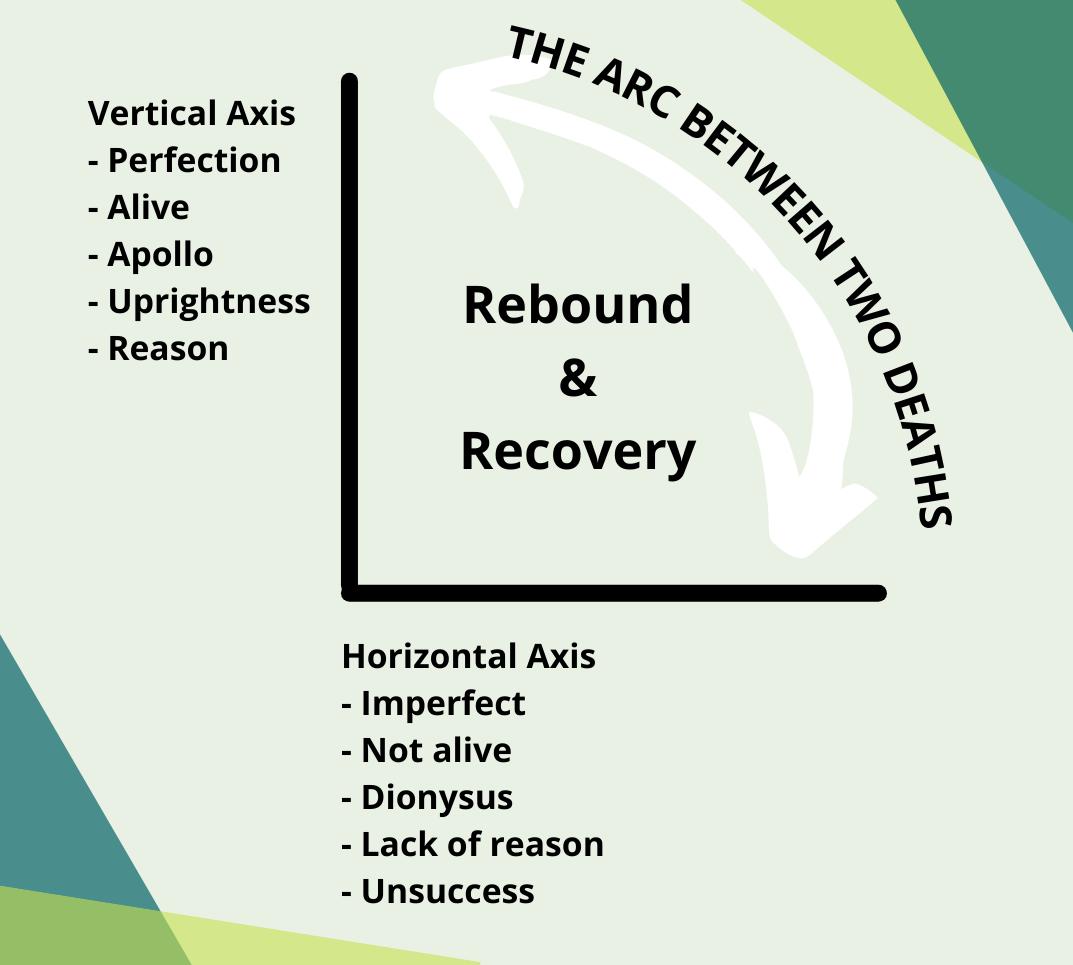
JD McCormick Properties presented their proposal for a new housing development on State Street to the Urban Design Commission Feb. 9. The plan includes 23 to 26 apartment units and some public fixtures, such as a restaurant and a place for murals. Controversially, these developments would replace Sencha Tea Bar, B-Side Records and Freedom Skate Shop, which are some of the most beloved local businesses and icons on State Street.
JD McCormick representatives argue their development is intended to bring modern elegance that would help revamp State Street for Madison residents. They insist that the project would be a positive cultural addition to the area.
Meanwhile, some citizens worry how the displacement of local businesses could impact the culture of State Street. For many residents, small businesses are crucial to the identity of the city. Cultural landmarks like B-Side Records represent Madison’s interests and values, and losing this business would inevitably upset local residents.


More generally, small businesses like these provide a critical sense of community often lost when larger companies take over. Without them, there is a shift in local influence to larger corporations that are more likely to lose touch with the community.
Some citizens hold reservations about the JD McCormick proposal in particular. The apartments — considered “elegant” — may not be tailored to the specific housing needs of an area near the University of Wisconsin campus. District 8 Alderperson Juliana Bennett said the current average rent price of $800 per person is unaffordable for many UW students, many of which live in the State Street area.
With all of this in mind, it is difficult to discuss this issue without understanding the history of housing discrimination in Madison. Patterns of redlining from the early twentieth century are still identifiable on housing maps. This, coupled with rampant gentrification in the successive decades, has harmed lowerincome residents who are forced out of their neighborhoods.
The State Street and Capitol Square neighborhoods in particular are considered to be completely gentrified. This means that though the area was once home to a population of financially disadvantaged and diverse residents, the neighborhood has seen a significant increase in college graduates and a decrease in people of color. In other words, people and businesses living or renting in the area have been displaced for decades as real estate developments replace older, relatively affordable housing.
According to a report on equitable development in Madison, the Capitol Square and
State Street area are labeled as “appreciated.” Not only does this mean that they have been entirely gentrified and are no longer affordable according to general standards, but prices are still increasing.
This phenomenon should be cause for concern considering that displacing people and businesses can be deeply harmful to communities. It also poses challenges for people who take public transportation but are pushed out of downtown Madison to the edges of the city where it is less reliable.
On the other hand, economic principles of supply and demand demonstrate that creating more housing can decrease scarcity and prevent prices from becoming unaffordable in the first place. By this logic, building more apartment units on State Street would help mitigate Madison’s housing shortage, which is contributing to expensive buying and renting costs for residents.
According to UW Urban Planning Professor Kurt Paulsen, with the addition of apartment units that will be rented at or above market value, housing demands will be met and prices will drop in certain situations. Though the JD McCormick development could be unaffordable for some residents, increasing supply could help balance market forces in the long run.
This strategy was effective in the TenneyLapham neighborhood of Madison, a district located northeast of the Capitol Square. This area originally housed a mix of owners and renters. The construction of several multi-family
buildings shifted demand away from older homes, who then had to compete with pricing. As a result, rent costs have increased at a slower rate than the city average, keeping the area affordable.
In order to balance these economic issues with gentrification concerns, what is the best solution? Realistically, with just 23 to 26 primarily studio apartment units, it seems like JD McCormick’s development is unlikely to create enough of a supply to meet the demands of the city or have much of an impact on housing affordability. Construction at the planned location, however, could still harm the community with the loss of beloved local businesses.
Ultimately, Madison needs more housing, but JD McCormick’s development alone is not going to solve this issue. Larger public policy initiatives sponsored by the city government would be more likely to take root in Madison’s deeply gentrified neighborhoods. The Equitable Development Assessment suggests that measures such as eviction protections, housing subsidies and inclusionary zoning could help protect residents and businesses as developers aim to meet city demands.
Housing discrimination should not be viewed as an issue of neutrality, because almost every decision benefits or harms those disadvantaged by centuries of exclusion. Without considering the potential for gentrification in housing decisions, we could be perpetuating conditions of discrimination deeper into permanence.
Celia Hiorns (hiorns@wisc.edu) is a freshman studying political science and journalism.

For over two years, nurses at UW Hospital have been attempting to unionize to better protect their jobs and improve their working conditions, however, they have been met with continued hostility and union-busting tactics from the hospital’s administration.
UW nurses’ frustration with UW Health has grown due to erratic scheduling, understaffing and worsened working conditions. While the pandemic has exacerbated many of these problems, unionization efforts began before COVID-19 overwhelmed hospital capacities.
Nurses unionization demands prior to the pandemic already warranted action, and with increased stress on healthcare workers due to the pandemic, UW nurses deserve the right to unionize in order to better care for themselves and the patients they serve.
The strain the pandemic has put on hospitals and the healthcare system takes an individual — and often overlooked — toll on the health care workers. Cutbacks on staffing levels, health insurance and education benefits have increased the burden these nurses face. A culmination of overwhelming conditions have led to a feeling of defeat, burnout and even post-traumatic stress disorder among many nurses.
UW nurse Courtney Younkle showed concern with work conditions in an interview with The Badger Herald in February.
“It’s definitely been really frustrating and
stressful and you feel like the people that you work with just aren’t listening to you and they’re profiting off of your sacrifices,” Younkle said.
The National Labor Relations Act signed in 1935 grants the right to unionize for all U.S. workers. But, employers have since found many loopholes to this law, rendering it difficult to enforce.
Collective bargaining rights for most public employees in Wisconsin have also been severely weakened since former Gov. Scott Walker signed the right-to-work laws through Act 10.
Union membership in Wisconsin has steeply declined by 5.5% since Act 10 became law in 2011, with only 8.7% of public employees being members of unions as of 2020.
Unions play a crucial role in the fight for workers’ rights in the U.S., but union-busting remains commonplace by large companies and corporations that know they are better off when their employees lack the collective bargaining power of a union.
UW Hospital received its own special status in 1996 when it became a public authority separate from the university. The legal debate over how Act 10 now affects these employees remains tense.
UW Health nurses already signed over 1,500 cards in favor of union recognition that were presented to the UW Health administration in January. If formed, the nurses’ union would total 2,600 members.
But, UW Health CEO Dr. Alan Kaplan claimed in a letter to UW Health employees
that state law prevents the hospital from recognizing the formation of a nurses’ union.
“I am asking and hoping that those passionate about a nurse union fully commit to our team efforts,” Kaplan said.
Rhetoric of teamwork and camaraderie in the workplace is a common union-busting technique to make employees feel as though they are failing as a team member if they want to unionize.
Kaplan’s claims that his hands are tied come from findings of a Legislative Council memo commissioned by Sen. Melissa Agard, D-Madison, in May of 2021, which states that “[UW Hospital and Clinics Authority] employees do not have a right to negotiate on subjects of collective bargaining,” but that a “meet and consult” relationship between nurses and UWHCA is legal.
Despite this, a December legal analysis from the Service Employees International Union Healthcare Wisconsin directly contradicted these findings, arguing “Act 10 did not affirmatively prohibit UWHCA from engaging in collective bargaining with its employees.”
If UWHCA truly thought that Act 10 prevented them from collective bargaining with nurses, they would not be running an anti-union campaign at the hospital to scare nurses out of unionizing.
UW Health needs to stop hiding behind the interpretation of Act 10 that best suits them and allow their nurses the right to unionize. Unionization would allow the nurses to negotiate salary, scheduling, time off and working conditions.
The SEIU argued in a press release that the hospital can afford to meet nurses’ demands on many of these issues, considering the UW Health system’s 162% profit increase in 2021.
The hospital has attempted other unionbusting techniques as well.
Nurses say they have seen some improvements in hospital conditions, but none of them substantial enough to make a lasting impact.
This is referred to as the “wait and see” method, which refers to an employer making minimal changes to a workplace to satisfy employees until talk of union organizing dies down. Afterwards, conditions typically return to normal.
The Madison City Council Alderpersons Lindsay Lemmer and Patrick Heck also wrote in a press release that UW Health is currently contracting with Axley Brynelson, LLP and Chessboard Consulting. With the help of these two anti-union consultants, the hospital has escalated fear tactics against nurses.
According to the press release, these methods include one-on-one meetings with nurses and security guards threatening nurses with arrest for informing their colleagues about unions.
Though it is illegal in the U.S. to fire a worker for trying to unionize, UW nurses
Photo - The pandemic has added strain to already difficult conditions, which warrants unionization
Cima TheBadger Herald
still fear unfair punishment for unionization attempts.
These fear tactics only further emphasize the need for a nurses’ union at UW Hospital.
A union would benefit UW hospital by ensuring that nurses avoid burnout and can perform their jobs to the best of their abilities. Unionization also has the potential to lead to less staff turnover and better patient health outcomes.
“If you’re short-staffed, the patients are still there. … People don’t get the top level of care that they deserve,” UW Health employee Delia Pertzborn said to The Capital Times. “We are having to triage what is the most important thing to do for people.”
It is time for the UWHCA to stop making excuses and acknowledge the nurses’ right to have a voice in their workplace.
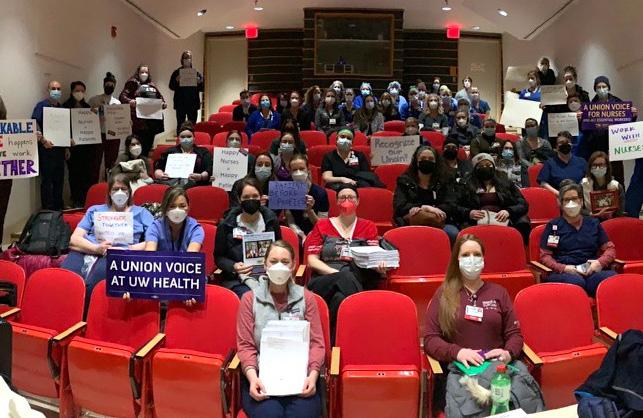
With tensions continuing to rise between UW nurses and UWHCA, it is crucial to support the fight for workers’ rights and hold UW Health accountable for their anti-union campaign.
We have spent two years relying on nurses’ labor to get us through the pandemic and calling nurses essential — it is time to treat them like it.
Leah Terry (lmterry@wisc.edu) is a junior majoring in political science and communication arts and pursuing a certificate in public policy.
 by Fiona Hatch Opinion Editor
by Fiona Hatch Opinion Editor
In early January, Republicans proposed Senate Bill 837, which aims to eliminate university administrators’ qualified immunity from lawsuits regarding alleged violations of students’ free speech.
A hearing held by the Senate Committee on Universities and Technical Colleges on Feb. 10 heard testimony advocating for the bill’s implementation into the University of Wisconsin System.
This was not the only bill heard by the committee. Also on the agenda were two other proposals, one of which aims to make classes on the U.S. Constitution and Bill of Rights applicable to fill the ethnic studies requirement in Wisconsin universities. The other would ban teaching on topics that promote “race or sex stereotyping,” which Republicans claim constitutes “critical race theory,” in college classrooms.
The groups intended to benefit from these proposals are those who hold traditionally conservative opinions, which has been a consistent trend in the Republican legislature’s agenda. In 2017, a failed bill proposed by Republicans advocating for the expulsion of students who disrupted public speakers three or more times resulted in real action from the UW Board of Regents, who ended up creating a resolution that mirrored the bill.
During the Senate Committee hearing, Katrina Shankland, D-Stevens Point, emphasized the fact that there are already First Amendment protections at the state and federal level, according to WPR.
“At least some of the bill authors were more interested in putting forward a bill that was designed to be political and furnish political talking points during the year 2022,” Shankland said.
Rep. Rachael Cabral-Guevara, R-Appleton, pushed back on this criticism by highlighting the complaints of conservative students who have expressed that their opinions are stifled in the current academic climate.
“How many times have you felt targeted, penalized, or isolated based on your viewpoints at UW-Madison? We have all had an experience where a professor, TA, or campus administrator has treated us differently based on our conservative values,” UW’s GOP Badgers said in an email to its members, urging them to support the bill.
It is vital, however, to look at how much of the content of these complaints is about freedom of speech restrictions, and how much is related to discontent over the subjects being taught. There is a difference between being unable to voice an opinion and being unwilling
to recognize a topic at all.
The goal for Republicans is clear — free speech must be maintained over supposed political correctness. But the reach to which speech should be protected is more selective than conservatives supporting these pieces of legislation want it to appear.
It is becoming increasing clear that the boundaries of free speech are not universal between political groups. According to a study conducted by the Knight Foundation, different political parties hold opposing opinions over whether or not free speech is guaranteed on subjects that are notoriously partisan.
For example, 44% of Republicans believe that spreading COVID-19 vaccine misinformation is a legitimate expression of the First Amendment, while this percentage is significantly smaller in Democrats, with just over 20% in agreement.
On the other side, only 56% of Republicans believe that the Black Lives Matter protests that occurred in the summer of 2020 fit within the bounds of free speech, compared to 85% of Democrats.
Critical race theory has been an increasingly controversial educational topic in recent years. The basic assertion made by CRT scholars is that racism is not the product of individual bias, but rather something that is inherently embedded in U.S. legal systems and policies, which must be reevaluated if racism is to ever be completely eliminated. This claim sparked sparked outrage among conservatives, with the most common attack being mounted from white individuals who do not want to be labeled as inherently racist.
The irony of this argument — which does not accurately interpret critical race theory in the first place — is how it demonstrates the need for open conversations and teachings about topics surrounding racism and discrimination. Recognizing this, any bill requiring a ban on the teaching of critical race theory actually undermines the notion of free speech. It is especially interesting to note that two bills with extremely contrasting views on freedom of speech are being pushed not only at the same time, but by the same party.
This brings us to the point where one must ask a few basic questions — how far can free speech be pushed, and at what point is the argument no longer about free speech at all?
Debate among scholars is of course an important part of higher education and academia. But the issue with proposals such as these is the disparity it creates regarding who is allowed to express their opinion.
It is also important to recognize that by removing qualified immunity, the academic culture on campus could change considerably. Specifically, relations between professors and
students could look completely different.
“It is all too common on college campuses for students’ ideas to be silenced if they’re not the same as a professor, class or student organization,” co-author of Senate Bill 837 Clint Moses said.
Under the proposed legislation, students would be able to sue the UW Board of Regents, which could make instructors hesitant to cover topics that are politically controversial by nature of the subject matter. There must be a space available for students to question and debate these ideas, but not at the expense of learning the facts of uncomfortable or difficult subjects.
Additionally, by introducing another bill at the same time which would ban the critical race theory from being taught in classrooms, there is a clear answer as to which courses and professors would be the most at risk of being
punished under the legislation.
This debate is no longer about free speech. Senate Bill 837 may in itself promote an important protection for the First Amendment in the UW System, but the political climate under which it is being pushed, the Senators backing it and the accompanying bills all give the context necessary to realize that the end goal is not to give everyone a voice, but to change whose voices are allowed to be heard.
Freedom of speech is a necessary right to our democracy. But it is counter-intuitive to curtail the educational decisions of a university professor, especially when the most targeted subjects would be difficult, partisan as well as critical in content matter like systemic racism.
Students should be allowed to debate — but professors must be allowed to teach.
Fiona Hatch (fhatch@wisc.edu) is a freshman studying political science and international studies.
With March Madness around the corner, the Badgers (14-4) secured the top spot in the Big Ten and moved up the rankings to No. 10 in the NCAA over the weekend
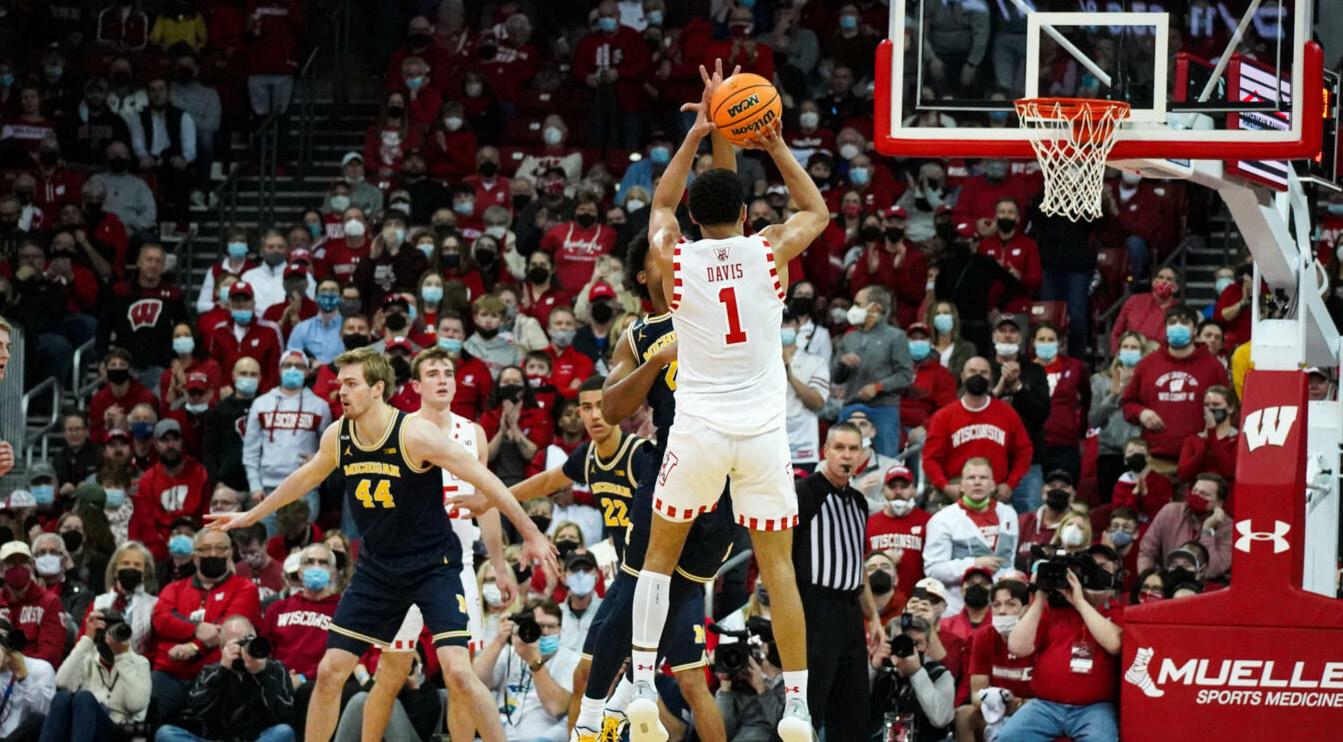


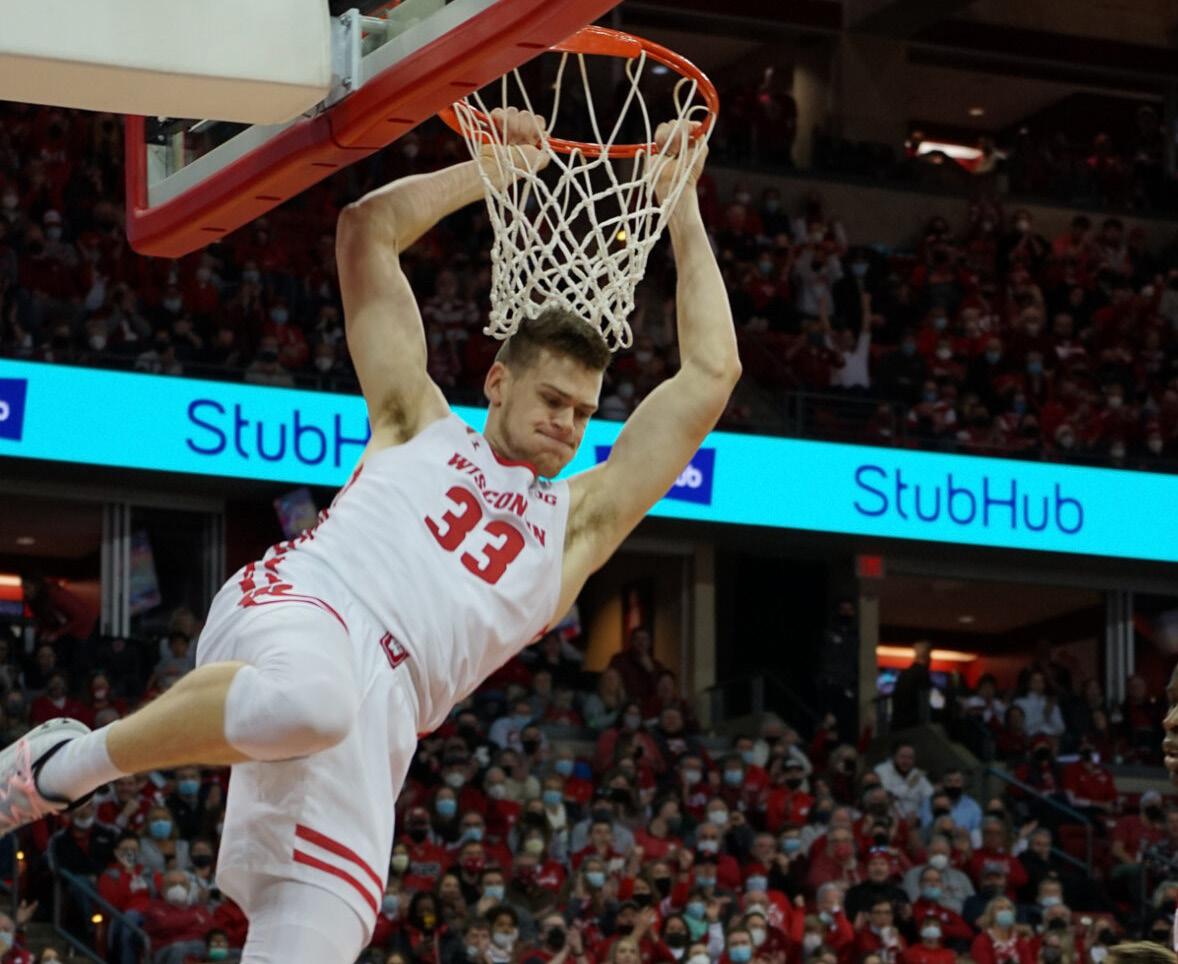


It’s March, and while many people associate this time of year with basketball, the college wrestling season is approaching crunch time as well. The dual meet season is over and individual competition is here, starting first with the Big Ten tournament March 5-6 and followed by the NCAA tournament in Detroit, Michigan March 17-19.
As a team, Wisconsin (12-2, 6-2 Big Ten) had a very strong year, losing only to Nebraska and Iowa. With experienced veterans as well as some quickly rising fresh faces, there are several Badgers with serious aspirations to compete and place at nationals in Detroit. Plenty of wrestlers had fantastic seasons, but to reach their long-term goals, success in March is pivotal.
It is difficult to start with anyone other than freshman Dean Hamiti, who has burst on to the collegiate wrestling scene with relative ease. Wrestling at 165 pounds, Hamiti is 20-1 in his inaugural season at UW, with 17 bonus point victories.
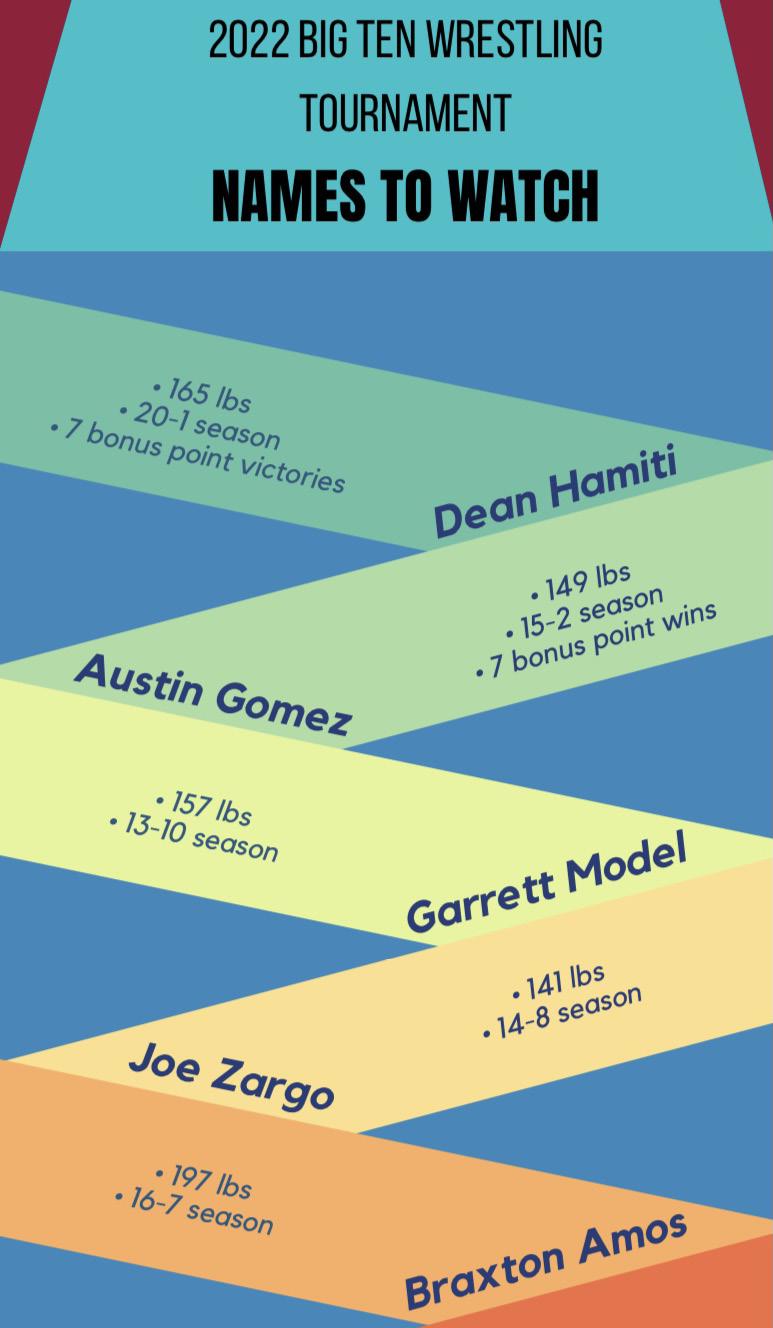
With his one loss to Iowa’s Alex Marinelli, a sixth-year senior, in a close 8-5 match, Hamiti has gained real attention as a contender at nationals. Most likely as a top-six seed, Hamiti will have his sights set for a top spot on the podium and is the Badger most likely to be named an All-American.
Another newcomer to UW, Austin Gomez, also had an incredible season that has put him back on the national stage. The Iowa State transfer was out of wrestling for two years before his season debut for UW and is now on the verge of completing his comeback story. Gomez, a 2019 NCAA qualifier, is 15-2 on the season with seven bonus point wins. In a very stacked 149 pound bracket at the Big Ten tournament, Gomez will have an opportunity to earn a top-six seed at nationals. While it was unthinkable a year ago, Austin Gomez has a legitimate shot to be an All-American this season.
To have gotten to this point without naming the two 2021 All-Americans on UW is a testament to how strong the program has become under head coach Chris Bono. Both Eric Barnett and Trent Hilliger are back and looking to add to their hardware collection. Their experience last year will be a major help for both of them. Barnett is 13-2 and is expected to be in position for a topeight finish and an All-American nod. Hilliger has finished strong this season to get to 16-4 and will look to add a second All-American honor to his name in his last year of eligibility.
While those four wrestlers all could be wrestling deep into the NCAA tournament, they will not be the only Badgers represented in Detroit. Based on the results of the Big Ten tournament and how seedings shake up, UW could expect to have around nine wrestlers at the national tournament, give or take. While expectations will vary for all of them, there is an understanding that anything is possible in March.
After all, nobody expected Eric Barnett to be an All-American in 2021.
Among the other wrestlers likely to be competing as March progresses is freshman Joe Zargo. Wrestling at 141 pounds, Zargo is 14-8 on the season, including an upset win over Dylan Duncan of Illinois, who was ranked No. 4 at the time of the match. Having shown flashes of brilliance to help the Badgers throughout the season, Zargo is a wrestler to watch for upset victories in March.
Fellow freshman Braxton Amos has also gotten off to a successful start at UW, wrestling at 197 pounds. The former highly-touted recruit is 16-7 this season and without a doubt has the skill to go on a run in March. Amos and Zargo are not widely talked about as contenders at the NCAA tournament, but both have what it takes to string together wins.
While it is just the beginning for the freshman, the Badgers also have a few seniors along with Hilliger who are looking to finish their collegiate careers strong. Garrett Model is one of them, with a 13-10 record at 157 pounds this season. Model was named Big Ten Wrestler of the Week Jan. 19 after his upset victory over No. 4 Brayton Lee that helped the Badgers defeat Minnesota on the road. Model will need a win or two of a similar caliber to place at the national tournament, but he will look to finish his UW career off right regardless.
Along with Model, Chris Weiler and Andrew McNally are seniors who hope to be wrestling in Detroit as their careers come to an end. McNally, a three-time NCAA qualifier for Kent State, is 8-8 at 174 pounds in his first season at UW. Things haven’t gone exactly how he would have liked, but McNally wills attempt to use his postseason experience to prove himself at the Big Ten tournament.
Weiler, a former Lehigh transfer, is also a three-time NCAA qualifier. While his first season for UW in 2021 was a success, it has not been replicated his senior year. Weiler is just 9-11 this season at 184 pounds, but did have a victory over Mayland’s Kyle Cochran, who was ranked 11th at the time. Both Weiler and McNally will look to turn their seasons around and make their fourth trip to the NCAA tournament.
In the stacked Big Ten, all of the UW wrestlers will face challenges in their conference bracket prior to nationals. The results of the conference tournament will determine for some if they make the NCAA tournament and for others answer questions about seeding for the big leagues. As a team, there is very little doubt that this season has been a success for UW. But when it comes to individual success, it is commonly measured by achievements in March — All-American, AllConference, NCAA qualifier. The Big Ten and NCAA tournaments will be opportunities for UW wrestlers to go after their individual goals while also providing well-earned exposure for the program’s overall success.
With an esteemed reputation, Wisconsin Badgers are flourishing in the NFL. The Watt brothers, Russell Wilson and recent Super Bowl winners David Edwards and Bob Havenstein are regulars in our Sunday entertainment, however, the rocky road to becoming a star in the league is long and arduous as players are nitpicked and scrutinized heavily.
After a rigorous film review by each NFL team, players first display their abilities at the NFL Combine, also referred to as the “underwear Olympics.” Held annually in Indianapolis, players are selected by the Players Selection Committee and invited to show off their football skills and mental acuities through a series of interviews, medical and cognitive tests, and physical drills. Everything from IQ to hand size to vertical jump is measured.
This year, five former Badgers were invited to the NFL Combine, which will take place from March 1-7. Here’s a closer look at each player’s potential at the professional level and what their current draft stock looks like. Let’s dive in.
talent at the tight end position. Tight ends often have a longer learning curve at the professional level, but scouts are optimistic that Ferguson can have an immediate impact. The Madison native is viewed as a red-zone and play action specialist as scouts favor his size (6 feet, 5 inches, 244 lbs.), ball skills, and catch radius.
Exceeding 400 receiving yards in three of his four seasons, Ferguson is both reliable and versatile, demonstrated by his strong performance at the 2022 Senior Bowl. As a blocker, however, Ferguson sometimes struggles. Sustaining blocks is a weakness, and he struggled against larger defenders in his college career. Improving his blocking ability will be critical to his professional success. Many scouts believe he can be a trustworthy TE2 at the professional level. Expect Ferguson to be a fourth- to sixthdraft pick, around the fifth overall TE selected.
At Wisconsin, he mostly played in a zone blocking scheme and wasn’t asked to pull often. He excels in foot speed, quickness, and footwork. With an excellent football IQ, Bruss can react quickly to plays, and is difficult to beat in assignment. Bruss will need to work on strength and getting to the second level of defenders (i.e., linebackers) to succeed in the NFL. Known as a great run blocker, Bruss possesses tremendous lateral quickness that should translate well. A gritty player, the 6-foot-5-inch lineman weighing in at 316 lbs. is currently ranked seventh overall in guards, according to Mel Kiper. Expect Bruss to be a sixth- or seventh-round pick.
Leo ChenalScouts love Ferguson’s experience as a three-year starter, and he is a promising
As a four-year starter, Bruss has played in 41 games as a Badger. His accolades include All-Big Ten (third team) in 2020 and AllBig Ten (second team) in 2021. The redshirt senior played a multitude of positions in Wisconsin’s offense, including right tackle, right guard and blocking tight end. Bruss is expected to play right guard in the NFL, but his versatility is certainly a strong suit.
Coming off a phenomenal junior year, the 2021 Big Ten Linebacker of the Year shows a lot of promise and you will certainly be seeing a lot of Chanel on Sundays. In 2021, Chanel led the Badgers in tackles (115) and sacks (8). Commanding the No. 1 ranked run defense in the country, Chanel excels in an aggressive defense that is blitz heavy. Scouts expect him to mostly play in early down situations because of his dynamic skillset and versatility.
Known as being consumed by football, the 6-foot-two-inch linebacker weighing in at 250 lbs. possesses tremendous on-field instincts in addition to being a vessel of energy. Despite his above average reads in assessing the rush, Chanel struggles in pass coverage and reading quarterback tendencies. Chanel is currently ranked seventh in interior LBs in Mel Kiper’s mock draft.
Most scouts are expecting him to go around the fourth round, however, many Wisconsin linebackers have been severely undervalued, and Chanel compares well to former Badgers like TJ Edwards and Chris Borland.
Like Chanel, Sanborn holds a tremendous fervor for the sport of football and is one of the better blitzers in this year’s draft, flashing ferocity in the line of attack and in pursuit. Blitzing in the NFL, however, is decreasing in frequency due to the increase in athleticism, the improvement in play of quarterbacks and skills position players. Say thank you to the Chiefs for this trend. Accordingly, teams are looking for more well-rounded linebackers who can excel in both man and zone coverage.
If Sanborn were to become a three-down linebacker, he would especially need to improve in man coverage. The three-year
starter excels at the line of scrimmage as his functional strength allows him to move quickly and efficiently through blocks. Still, Sanborn is a jack of all trades. He had three interceptions in 2019, led the team in tackles in 2019 and 2020, and had the most tackles for loss in 2021 (14.5). Scouts’ project that Sanborn will most likely be anywhere from a third to fifth round pick.
The former Badger quarterback has the chance to play at the next level, albeit most likely in a backup role or as a game-managing quarterback (i.e. Jimmy Garoppolo). In his one year at Notre Dame, Coan’s highlights included an utter beatdown of his former team and an impressive Toledo comeback victory, among others successes.
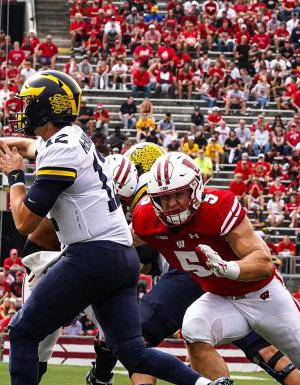
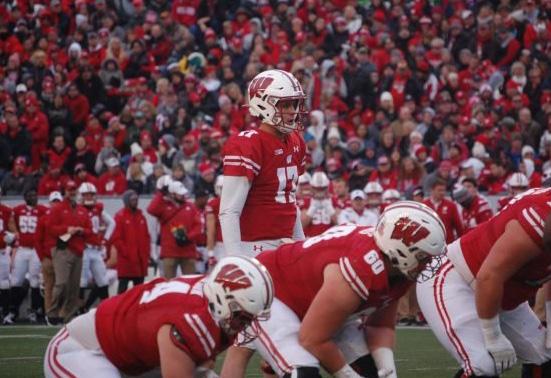
There is a dearth of quarterback talent in this year’s draft, and as a result, an anxious team might take a leap of faith on Coan. Scouts love his footwork and his deep throwing ability. Coan has tremendous arm strength and toughness.
To his disadvantage in a world of elite quarterbacks, Coan has a laundry list of weaknesses —mobility, poise and decisionmaking are among his top struggles. Most scouts have Coan ranked as the No. 10-12 ranked QB in this year’s class, and he will most likely be a seventh round pick or sign as an undrafted free agent.
As the 2022 Wisconsin Badgers soar above and beyond expectations, it’s a good time to look at how this team has changed and improved from the squad of a year ago.


The 2021 Badgers finished the regular season with a record of 18-13, going 10-10 in the Big Ten and losing in the second round of the NCAA tournament to Baylor, who ended up winning the NCAA championship.
The Badgers’ team was led by senior point guard D’Mitrik Trice, who averaged 13 points, three rebounds and four assists per game.
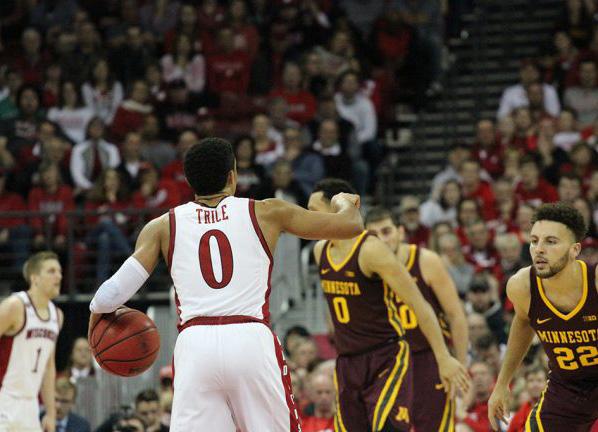
Trice ended his career with the Badgers as a two-time third-team All-Big Ten selection, providing Wisconsin a consistent and reliable ball-handler to run the point.
Upon completion of his tenure at UW, Trice signed to play overseas in France with FOS Provence Basket of the LNB Pro A league. He played one season, averaging five points, an assist and a rebound per game before signing with Śląsk Wrocław of the Polish Basketball League, where he is yet to play in a game.
Trice will continue to look to build upon his international basketball career and find a team where he is able to play at a high level.
The Badgers took a hit after the 202021 season in terms of their big men, losing important pieces in Nate Reuvers and Micah Potter. Potter averaged 13 points, five rebounds
and two assists per game, while Reuvers put up six points, three rebounds and an assist.
Potter was a huge part of the team, providing great size and an inside scoring touch that the 2022 team could surely use. He ended up undrafted in the 2021 NBA Draft, but he later signed with the Miami Heat for the summer league and signed a G-League contract with the affiliate, the Sioux Falls Skyforce.
Potter played very well in the G-League, averaging 14 points and 10 rebounds per game. His performance earned him a 10-day contract with the Detroit Pistons earlier this NBA season, but his contract was not renewed after it expired. Potter is still looking to be signed out of the G-League, and his performance certainly shows signs of hope.
Reuvers finished his college career and moved onto a team in the Croatian League called Cibona, who also play in the ABA league.
Another big loss for the Badgers entering the 2022 season was forward Aleem Ford, who averaged nine points and five rebounds per game. Ford was a consistent piece for this Badgers squad, starting every game of the 2021 season. His play steadily improved during his time in Madison and has continued to improve since his departure.
Ford was drafted first overall in the Puerto Rican Baloncesto Superior Nacional to a team called Leones de Ponce. He’s now playing for
the Lakeland Magic of the NBA G-League, the Orlando Magic affiliate. He signed a 10-day contract with the Orlando Magic in December and played in one game, scoring two points. Similar to Potter, Ford got a big opportunity to play in the NBA as a result of strict COVID protocols.
Finally, the kids who never left. Junior forward Tyler Wahl and senior guard Brad Davison are both contributors from 2021 still on the team, and they’re both playing better than ever.
Wahl is averaging 12 points and four-pointfive assists per game — now the team’s biggest inside scoring threat. Despite being relatively undersized for a big man, Wahl plays up to the role and consistently finds a way to get buckets in the paint. It’s impossible to measure how important Wahl is to this team, as he brings a style of play no other player brings.
Davison is proving he made the right decision to stay with Wisconsin for another year, averaging 11 points and four assists. The energy Davison brings to the floor every game is unmatched, and his maturity and experience help provide leadership to a relatively young new squad. He’s also a big-shot player, consistently hitting important late-game buckets when the team needs him most.
The 2021 Badgers weren’t the best team in college basketball, but they had a lot of talent on the roster and it’s beginning to show now. With multiple players in the G-League and
others in Europe continuing to improve their game, the future seems to be bright for the Badgers — no matter where their paths might take them.
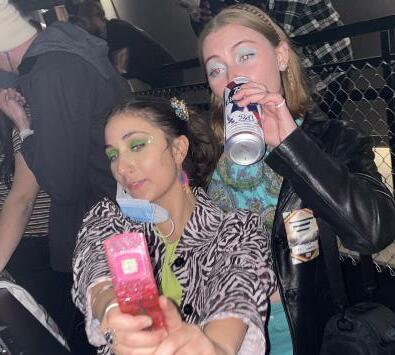
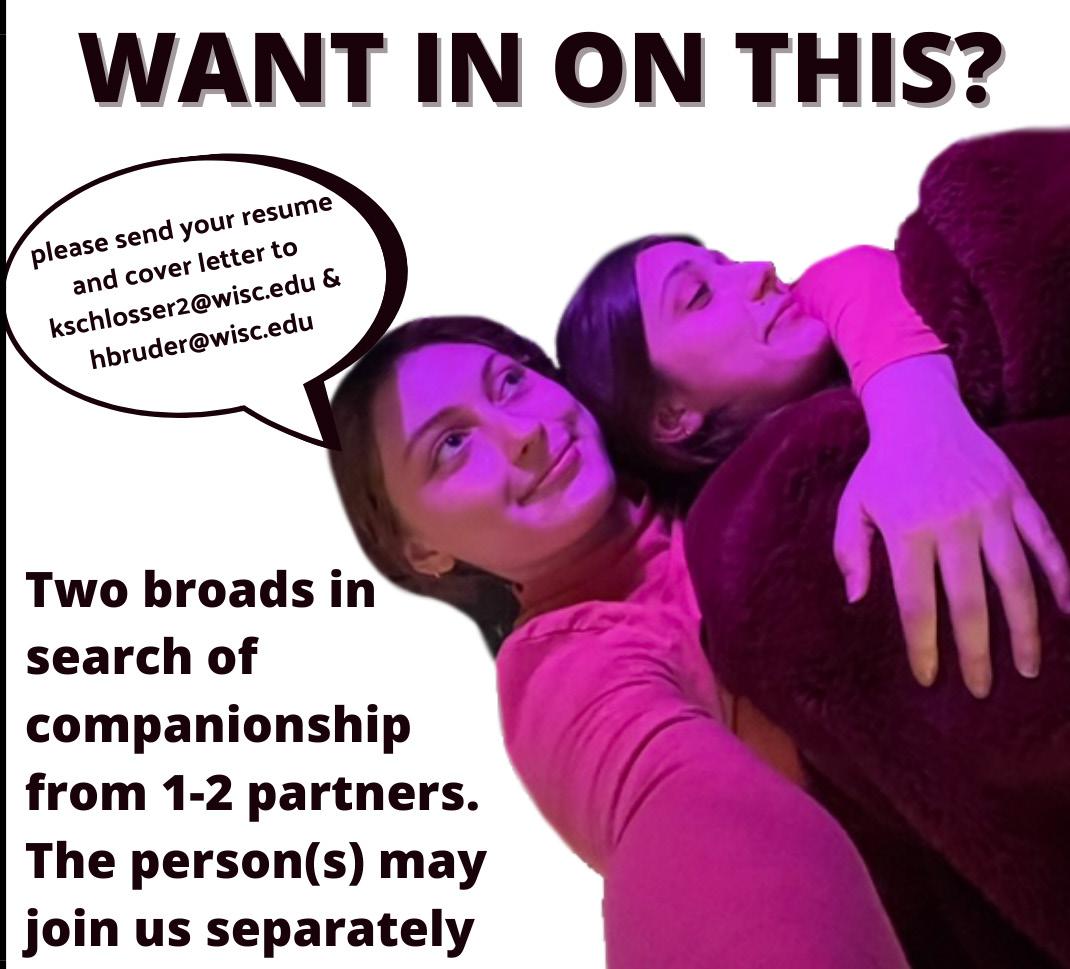 by Hannah Bruder and Keagan Schlosser Best friends/lovers
by Hannah Bruder and Keagan Schlosser Best friends/lovers
Sunday. 6:47 p.m. T-13 minutes until the Sylvee doors open for the Still Woozy concert. Two smoking hot best friends (the writers of this story) finally acquire their media passes after nine different calls to the Sylvee box office. A quick change and dinner (soup) at the bus stop follows.
We were waiting, wearing the wooziest of wardrobes, behind a line of pertineer (pretty-near, for those who didn’t grow up on a farm) 212 eager Zeta Kappa rejects. The next 30 minutes were spent attempting to turn off our digital camera’s flash… something we had been trying to do since dinner.
We walked through the doors to what we thought was a Nirvana cover band singing Heart-Shaped Box. Turns out, it was Wallice — the opener that Keagan was “on assignment” to cover. We weasled up to the balcony, surrounding ourselves with millennial couples AKA our only allies. When we looked down to the pit we saw a mere two tropes of male specimen — boys in golf polos (fratty) and boys in golf polos
(indie). The only way to spot the difference between the two was due to the nose rings in plain sight, as masks sat just below their noses.
Hannah — still maneuvering her way around the Nikon D3500 — took some of the worst pictures of her life, but at least the flash was off (baby steps). Then, the edible kicked in.
Ear plugs in, mask on, brain out. To supplement the slow degradation of our hippocampus (the part of your brain that controls memory and is most affected by cannabis [or so we have heard {no scientific data to back this up}]), we jotted down some thoughts about the concert in our notes app. Here are some of our REAL live
“Audience very lull no dancing?? Why” ::: This was during the opener (female). My only guess is that Brad (KK) and Briston (Plaza) hate women.
“All very gentle head mods.. I’m scared” ::: Bird’s eye view of the Sylvee pit is a lot to take in.
“It is because if you dance seriously you Geel silly” ::: And boy, did we Gook silly.
“Like if the TJs cashier dressed in his “causal nice” clothes and tried to do an impression of….” ::: Post-concert introspection led us to believe the Trader Joe’s cashier, Sven Eric Gamsky, would be showing you his
“Had an extasgentuao crisis during so woozed out” ::: Read: existential. “So woozed out” is code for an unknown song title… still cracking that one.
“My favorite kind of friend is a class friend” ::: It’s true.
“Second one during habit but not t was till goood!” ::: That is, second existential crisis.
“Just realized that if I wasn’t wearing shoes or socks my outfit would only cost ~$2 #dignsave/street finds” ::: Apparently, Hannah went commando.

“Encores are so silly, did they start accidentally… probably” ::: Ending the night with an inquiring mind.
To recap, we survived the Still Woozy concert (+ Wallice. Don’t think we forgot about her. Check out her review online at badgerherald.com for the actual reason we got in for free #presspasses).
Between our high view from the balcony to the amount of berserk, and at times inappropriate, dancing we were annoying our seat neighbors with, the night was intellectually stimulating, wacky and definitely… woozy.
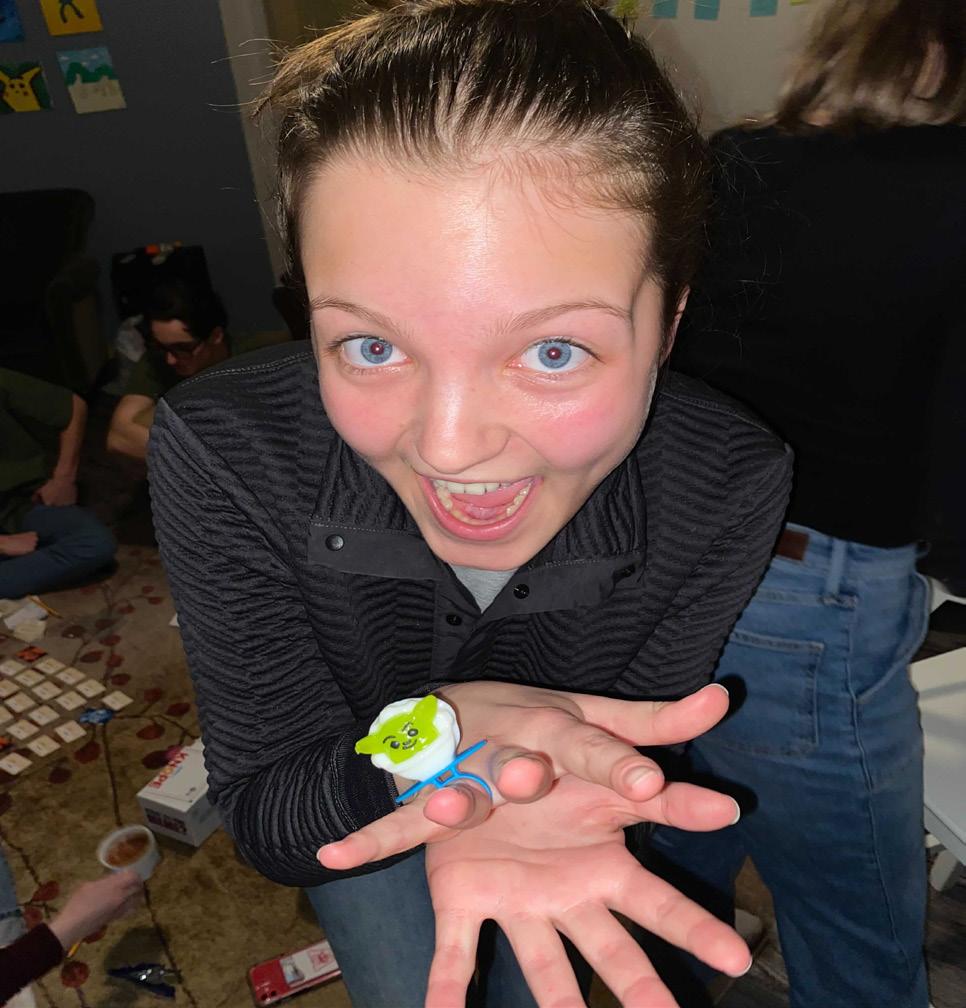
Spring break — we actually have one this year!
Some people are talking about blowing some serious cash on trips to Mexico and others are taking road trips to Gulf Shores — though if you chose this option I think you need to sit down and ask yourself, why?
I for one am excited for a week in the country’s number one city, and you should be too.
If you’re like me and you’re sticking around Madison for the week, if you have a late start on your spring break planning or if you’re just looking to take a spontaneous trip, I have some amazing options for you.

While all your friends are off scuba diving in Mexico, you could be exploring the gorgeous rocky bottom of Lake Mendota.
The Gulf of Mexico only has coral reefs, but Lake Mendota has a range of algae — not to mention the abundant numbers of walleye, bass and bluegill.
The brisk water temperatures will, no doubt, be better than the ocean. Who wants to swim in what feels and tastes like actual piss, anyway?
But when you’re packing, don’t forget an underwater camera — pics or it didn’t happen.

Do you like hiking? Well, fuck Picnic Point. It’s
cool for maybe two trips and there’s no elevation. The real hiking trip on campus is the stairwell of Van Hise Hall.
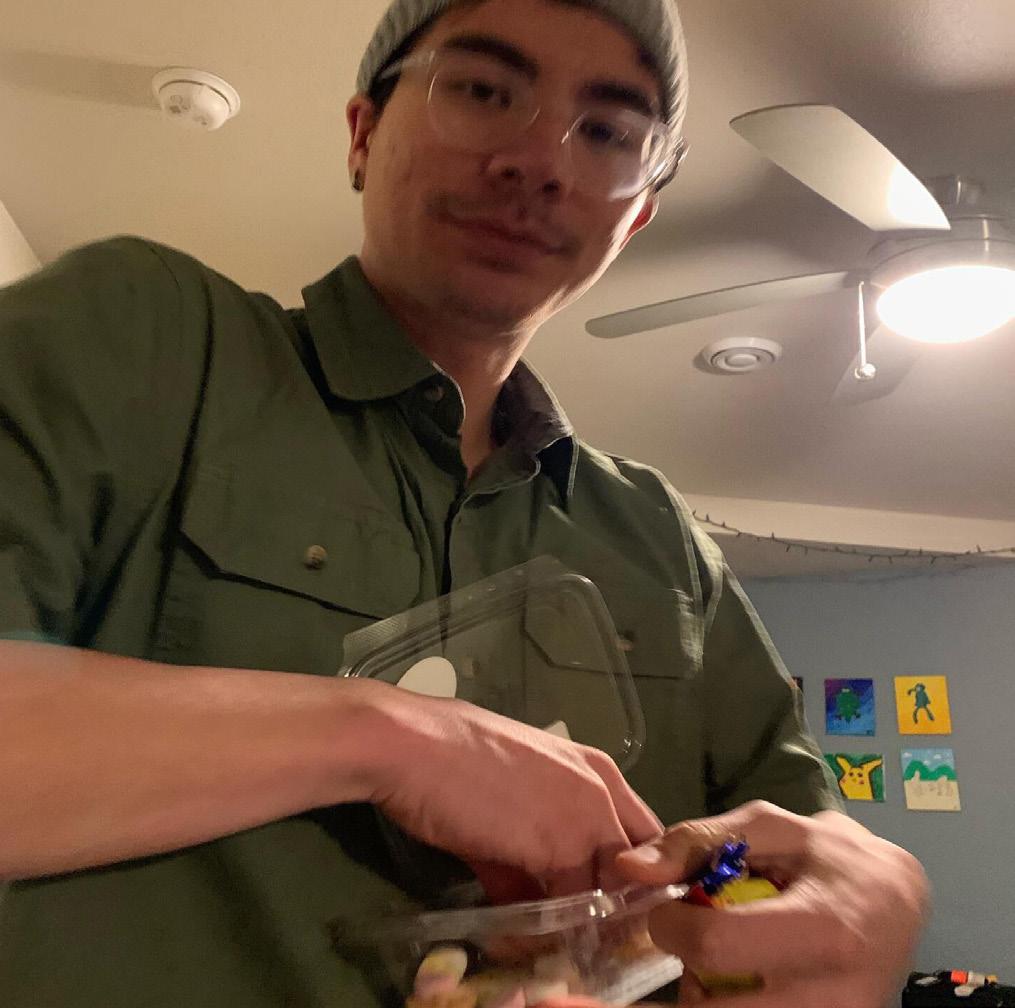
Avid hiker Jon Gallien attended this trip solo last semester to find himself — Alexander Supertrampstyle. Apparently, it rocked his world.
“There’s really nowhere in the world that’s better for hiking,” Gallien said. “It was the perfect challenge for me, and I learned a lot about the beauty of monotony.”
Who even wants to go to Disney or another basic-ass theme park with roller coasters when you could chill in Chadbourne’s middle elevator? It’s like the old Tower of Terror, except you never know if or when it’s going to free fall from the third floor to the first floor.
This trip even accounts for a day of complete serenity when the elevator inevitably gets shut down for maintenance. There won’t be any noise, because they won’t actually fix it!
When you get hungry, you can always head to the gourmet Rheta’s Market for the soggiest french fries of your life or the occasional piece of pizza wrapped in cardboard. Money-saving tip — eat the box, too! You won’t be able to tell the difference.
4. The fourth floor of Mosse Humanities
Are you looking for an adventure this spring break? Were you a fan of Percy Jackson as a kid? Then this is just the trip for you.
The elusive fourth floor of the Humanities building is the perfect weekend — or eternal — getaway. Enter, Greek mythology. This destination features a literal Labyrinth, including shifting rooms, walls and halls. Don’t forget to pack some string!
Ariadne Theseus took this trip last year and she’s still exploring to this day. Some people say they can hear her cries during their lectures, but it’s just Theseus laughing with the Minotaur. That’s right, the Minotaur has jokes — the benefits of being hated as a kid.
If you’re looking to explore a different part of campus, you should take a trip to Grainger Hall. Sorry, I should make it clear that I’m assuming exactly zero finance majors are reading The Badger Herald — or anything, for that matter.
If you decide to go to Grainger, make sure you leave immediately when spring break ends or you will catch COVID-19 as soon as you come face-tomaskless-face with a business major returning from their daddy’s yacht in Bora Bora.
The building’s library features hundreds of picture books for easy, recreational reading. Marketing major Josh Reynolds Sr. IX said the building is perfect for a chill week off.
“Yeah bro, the building is totally dark and sometimes you can get a professor to read you a bedtime story,” Reynolds Sr. IX said. “You could even bring a flask to the cafe and my boy Hoight Jr.
III will mix you his famous jungle juice.”
Well, there you have it — the five best places to vacation on our lovely campus. These options will save you time, money and also from going on a shitty vacation to a warm beach somewhere.
